DESIGN

p.43

WAREHOUSE


page 38
Absolute encoders –facts and misconceptions
NOTES: Mobile robots at the forefront of intralogistics technology
p.22
AUTOMATION: Fast-paced warehouse operations demand extensive automation, which is inconceivable without micromotors.
August 2023 www.designworldonline.com inside:
ROBOT REPORT: A detailed look at the challenges and opportunities that exist for the evolving world of humanoids.
p.71
THE
Warehouse Automation
71-90
Pages
CONFIGURATION SOFTWARE with thousands of ready-to-use objects









NEW! CM5 Series





High-performance HMIs





























The NEW C-more CM5 HMI series offers low-cost, high-performance HMIs in sizes from 4 inches (only $340.00) to an impressive 22 inches (only $2,299.00). With an amazing 1.6 GHz processor in the larger units (10” and above) and 43 Mbytes of memory, these HMIs provide better trending, extra data storage, faster communication, improved file types, and 16.7 million screen/object color options.




All CM5 panels have serial and Ethernet ports (dual Ethernet ports on 10” or larger models) that support many of the most popular industry protocols, including EtherNet/IP, MQTT, and Modbus. The included USB ports provide in-an-instant connections for keyboards, barcode scanners, memory storage, etc. and the embedded SD-card slot provides easy project transfers or up to an additional 2TB of data storage (depending on model) for important log files. Plus, all C-more HMIs come with FREE, powerful, easy-to-use programming software and FREE technical support!






the #1 value in automation Order Today, Ships Fast! * See our Web site for details and restrictions. © Copyright 2022 AutomationDirect, Cumming, GA USA. All rights reserved. 1-800-633-0405 Research, price, buy at: www.automationdirect.com/cmore How can an enhanced HMI be so affordable? Simple, it’s a C-more HMI from AutomationDirect!
HMIs starting at only: $340.00
FREE

















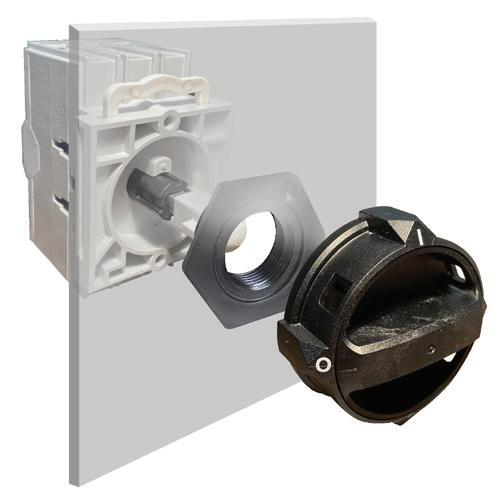




















• Optimize Application Space & Weight • Industry-Specialized Design Support • Large Selection from Stock • Easy to Customize Crest-to-Crest® Wave Springs SICK OF COILSICKSPRINGS? OF Request Free Samples at 847-719-5900 or smalley.com We were too. That’s why we invented the wave spring.
Reliable and quiet solutions for medical technology.












Clinics, hospitals, pharmacists and care services require adaptable, highperformance devices that provide you with the best possible support in medical settings. Whether the system has to cool, air condition, lift, pump or drive, ebm-papst’s ventilation and drive solutions make diagnosis and treatment more simple, efficient and cost-effective.


Scan to sales@us.ebmpapst.com
Science centers and STEM careers








As the father of two sons, I’ve been to more than my share of science museums over the years, from Cleveland to Portland, Ore. and San Francisco to Rochester, N.Y. These institutions have been playing an increased role in recent years in encouraging students to pursue STEM careers — as their very nature is to get kids interested in science and technology. Oftentimes, this is accomplished through having a little fun in the process, whether by allowing kids to control a robot or putting their hands inside a tornado-like vortex of smoke as they explore the Coriolis e ect.
I recently had the chance to tour the San Antonio Museum of Science and Technology (SAMSAT), which is connected to the Boeing Center at Tech Port. San Antonio’s Tech Port is a creative re-development of the old Kelly Air Force Base, which closed in 1998. Tech Port also includes the new DeLorian headquarters; the iconic car manufacturer is now planning to build a new electric vehicle called the Alpha5.
SAMSAT’s mission is to engage with children and get them excited about science and technology — from cybersecurity to rockets. There’s a lot happening here. It just moved into a new space in the past year. Boeing is in the process of building a new history of aviation exhibit that will be opening by the end of 2023. Plus, there’s a very cool LAN gaming center next door that feels like something out of Star Trek.
The museum has 500 artifacts across the street and more than 20,000 more in storage, so there are plenty of opportunities to grow. And there’s even a program where they bring in children from under-resourced neighborhoods in the city to participate in a weeklong space camp.
What really struck me was seeing real-world technology in the museum — a huge Fanuc robot and a Di Vinci surgical system proudly held center stage, along with the historical items like early desktop computers and cell phones. I believe that’s what we need more of today, showing kids the actual products that engineers create, not simply historical artifacts and far-flung futuristic ideas.
The products we’re already building are pretty awe-inspiring to our kids and can serve to engage them. While I’m constantly reminding our readers to get involved with local science centers and their FIRST robotics programs, it’s also a good idea to start a conversation about whether your company can donate some innovative products or machinery to those same centers. That could be the spark to send someone into a STEM career. DW

 Paul J. Heney - VP, Editorial Director
Paul J. Heney - VP, Editorial Director


Insights 4 August 2023 www.designworldonline.com DESIGN WORLD - brushed or bldc motors - 5 amps per axis - 16 analog inputs - 16 on/off drivers - home and limit in - live tech support - made in the USA WWW.ALLMOTION.COM (510) 471-4000 30097 Ahern Avenue Union City, CA 94587 Technical Support (408) 460-1345 See the EZQUAD SERVO in action! 2.25”
from NEW!
4 AXIS SERVO
On Twitter @wtwh_paulheney
pheney@wtwhmedia.com



















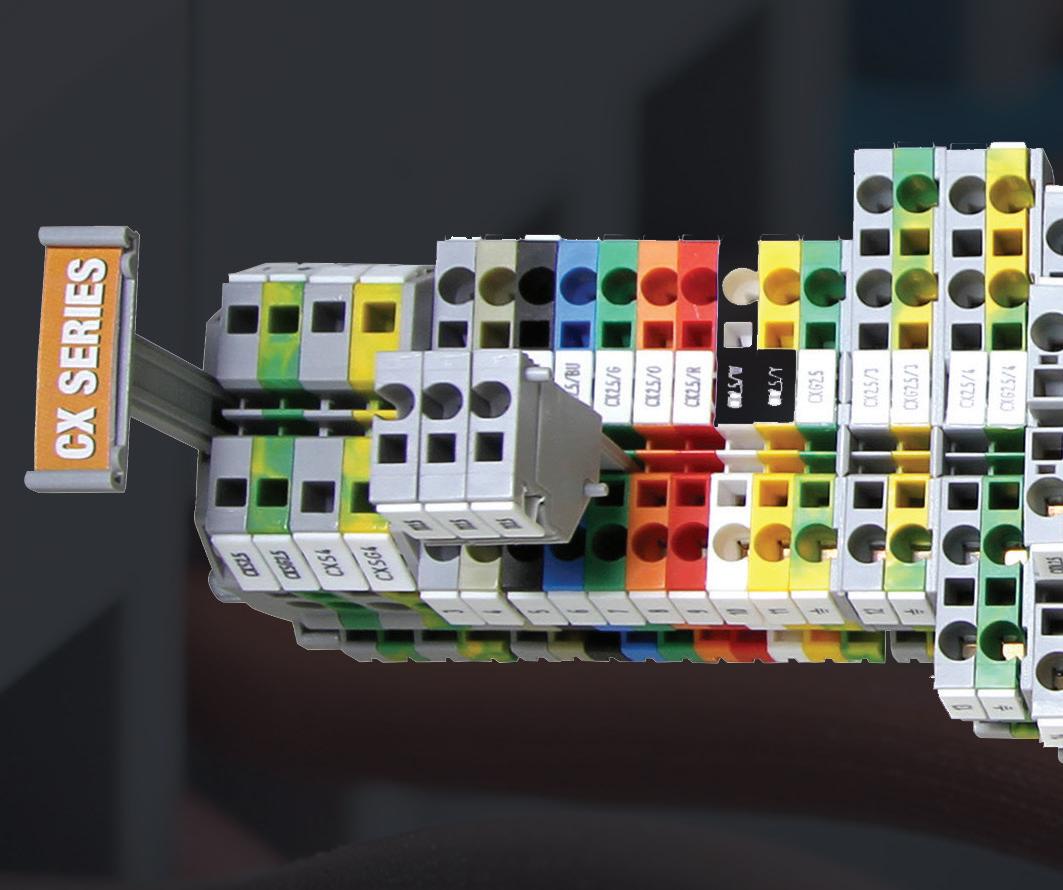

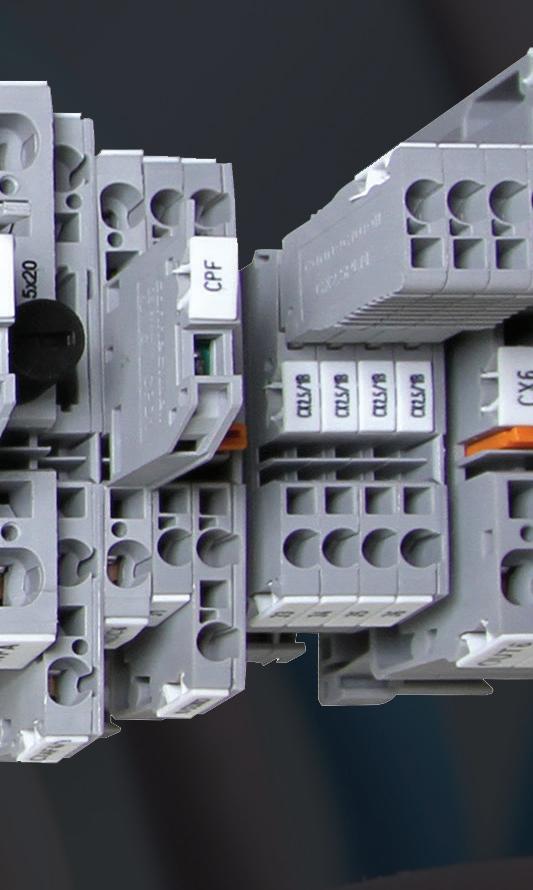



























What if AI drops were managed — not surprising?
Artificial intelligence (AI) has already proven revolutionary in industrial applications such as automated farming and agriculture. IoT devices collect weather, soil, plant, and nutrient data points and AI systems process this data for informed decision making, for example. In fact, AI-outfitted tractor and drone controls reliably boost crop yields, reduce waste, and make both agribusiness and family-scale farming more sustainable. Similar gains are being realized in manufacturing. Visit designworldonline.com/designguide-library for our cybersecurity installment detailing other AI solutions for connected enterprises.

But many — including Quad9 chief security o cer Danielle Diebler — are focused on how AI is already a tool for cybercrime perpetrated on individuals as well as general cyber … creepiness Quad9 is an open domain name system (DNS) recursive service aimed at giving individuals and organizations free security and online privacy.

“We’re a privacy-focused nonprofit organization o ering an opt-in service, and users don’t disclose who they are to us. Though we don’t have any information that’s even remotely personally identifiable even at an organizational level, we do know that manufacturers, large municipalities, government organizations, educational institutions, and IT administrators use our service,” Diebler explained in a recent interview with Design World
Especially concerning to Diebler are AI-generated emulations of living persons — complete with voice and realistic avatar — and the unique
threats these pose to personal cybersecurity. “We’re not really thinking about these avatars now. But how might we be represented via AI depictions extracted from public sources on the internet — and what ownership do we have over our own image, thoughts, and speech?”
It’s enough to make a gal want to delete her entire social-media presence.
But in the U.S., we’re not seeing legislation to protect identities.
“Consider how we have a data breach every other week, and people just take it in stride … they’ve gotten used to it. They say, ‘I’ll just buy dark-web monitoring and shut down the ability for people to open credit cards in my name.’ If we can’t protect a basic social-security number though, we’re certainly not going to be able to protect against what commercial organizations are going to be able to do with images and things like that,” Diebler adds.
Unaddressed ethics issues surrounding open AI also abound. “These technologies get released and enter public consciousness and then everybody realizes, ‘Oh my God, this is a huge deal. We should do something about this,” says Diebler. Society must define how we want to leverage this type of technology because AI will drive the next industrial revolution … except the
changes it spurs will come far faster, Diebler asserts. Should people need to give permission to allow their content to be used as training data for a given model? Should AI-generated content be required to be labeled as such?
“Having AI show me 15 ways to visualize something with a dataset behind it is a lot more useful to me than fake pictures of ex-presidents — because with those all you’re doing is making me try to figure out what’s real and what’s not,” says Diebler. “Instead, give me something that really adds to my productivity by leveraging an existing data set that I know is pretty good.”
Indeed, there’s much more than can be done to make AI much more beneficial for humanity — with welldesigned rollouts rather than what we have now — surprise drops that hit the news cycle and suddenly change everything while we have nothing in place for managing them. DW

Technology Forward
On Twitter @dw_LisaEitel www.designworldonline.com 6 DESIGN WORLD August 2023
Now it’s even safer and stronger with all-new features:




New bushing covers and inboard shaft guard
Improved backstop with more than double the holding capacity and extreme pressure lubricant compatibility



Sensor ready for remote condition monitoring via the OPTIFY™ platform






Sustainable Engineering
Paul J. Heney • VP, Editorial Director
World’s most remote robot automates Amazon
reforestation project
A pilot project between ABB Robotics and non-profit Junglekeepers is demonstrating the role that Cloud technology can play in making reforestation faster, more e cient, and scalable. The mission is to protect 55,000 acres of Amazon rainforest and reverse deforestation. In a first-of-its-kind demonstration, ABB’s cobot YuMi is automating planting tasks in a jungle laboratory, speeding up the process and allowing volunteers to focus their valuable time and resources on more impactful work. Through ABB RobotStudio Cloud technology, ABB experts simulate, refine, and deploy the programming required for YuMi’s tasks in the jungle from more than 7,000 miles away in Västerås, Sweden — enabling the world’s most remote robot.
“ABB’s collaboration with Jungle-keepers demonstrates how robotics and Cloud technology can play a central role in fighting deforestation as one of the major contributors to climate change,” said Sami Atiya, President of ABB Robotics and Discrete Automation. “Our pilot program with the world’s most remote robot is helping automate highly repetitive tasks,

8 August 2023 www.designworldonline.com DESIGN WORLD
freeing up rangers to undertake more important work out in the rainforest and helping them to conserve the land they live on.”
The jungle lab is in a remote region of the Peruvian Amazon; there, a YuMi cobot has been installed to automate essential tasks in the seed planting process, usually an entirely manual e ort. The cobot digs a hole in the soil, drops the seed in, compacts the soil on top and marks it with a color-coded tag. YuMi enables Junglekeepers to replant an area the size of two soccer fields every day in zones requiring reforestation.
By automating this task, Jungle-keepers’ volunteers are able to focus their valuable time and resources on more impactful work, such as patrolling the area to deter illegal loggers, educating locals on the preservation of the rainforest, and planting mature saplings.
Creating a fully remote and autonomous cobot installation also overcomes the di culty of finding people willing to stay and work in the distant jungle location. After its initial installation, YuMi can carry out its tasks autonomously, with only trouble shooting as needed.

“As of right now, we have lost 20% of the total area of Amazon rainforest; without using technology today, conservation will be at a standstill,” said Moshin Kazmi, Co-Founder of Junglekeepers. “Having Yumi at our base is a great way to expose our rangers to new ways of doing things. It accelerates and expands our operations and advances our mission.”
The destruction of the Amazon rainforest through human activities such as logging and burning to clear land for agriculture are contributing to the devastating e ects of climate change. It is estimated that more than 870,000 km² of the Amazon rainforest have been cleared since 1985, an area larger than France, United Kingdom and Belgium combined. With tens of billions of trees already gone, the region is warming fast.
“The Amazon is in danger. That’s why we need technology, science, and local knowledge to work together in order to save it. Otherwise, we will be too late. The rainforest can be saved, but we must bring together all these elements to make a di erence,” said Dennis del Castillo Torres, Director of Forest Management Research at the Peruvian Amazon Research Institute. “It is very important to have a combination of high technology and conservation. There are many technologies that we can use to preserve the forest, and this robot can help a lot to reforest faster, but we have to be very selective. We have to use it in areas of high deforestation to speed up the process of replanting.”
The pilot project is supported by ABB’s RobotStudio Cloud technology, enabling teams all over the world to collaborate in real time. This remote new way of programming enables new levels of flexibility and instant refinement, resulting in greater e ciency and resilience, and no loss of planting time. With more than 25 years of o ine programming experience, RobotStudio enables 99% accuracy between simulation and reality. This allows users to reduce time for testing robotic solutions by 50% and takes production downtimes to zero. DW
Robotics & Discrete Automation go.abb/robotics

Longer Lasting Belts & Pulleys
Better than Lifetime Warranty
We use 100% virgin urethane (no regrind waste). Makes stronger, longer lasting belts.
« Abuse Resistant Belts work where others fail.
« Super Strong Joints are virtually unbreakable.
« High Tension Belts move heavier loads.
« HEHT black belts double capacity.
« Low cost, highly efficient, elastic flat belts.
Split Line-shaft Spools

l High precision. Reasonable price.
l Easy to install. Zero downtime.
Round, Flat, Vee and Poly-V Belts and Pulleys

August 2023 9
www.designworldonline.com
ABB
Dura-Belt 800-770-2358 614-777-0295 Fax: 614-777-9448 www.durabelt.com
Longer lasting Belts, HEHT Split Spools -- no regrind wide_Layout 1 7/12/2023 3:10





Contents 8 • 2023 • vol 18 no 8 • designworldonline.com 10 August 2023 www.designworldonline.com DESIGN WORLD 43-69 71-90 ASRS WAREHOUSE AUTOMATION Covering the latest motion and control components, equipment and systems in ASRS design www.designworldonline.com A Supplement to Design World - August 2023 38 MOTION CONTROL Absolute encoders – facts and misconceptions Knowing and understanding the ins and outs of encoders and limit switches can ensure the best possible motion system design. asbpe.org SILVER REGIONAL AWARD 2023 asbpe rg SILVER NATIONAL AWARD 2023 asbpe.org asbpe.org BRONZE REGIONAL AWARD 2023 ON THE COVER Sizing and selecting the best mechanical solution for an application, especially where multiple axes are required such as in gantry systems, involves many design details and components, including encoders and sensors. 38















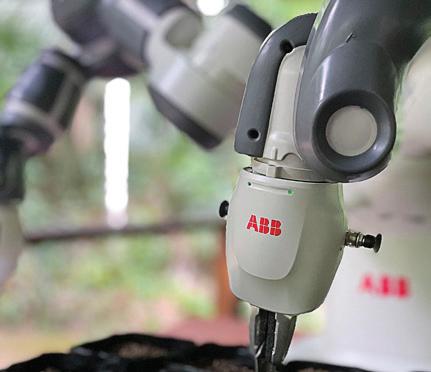






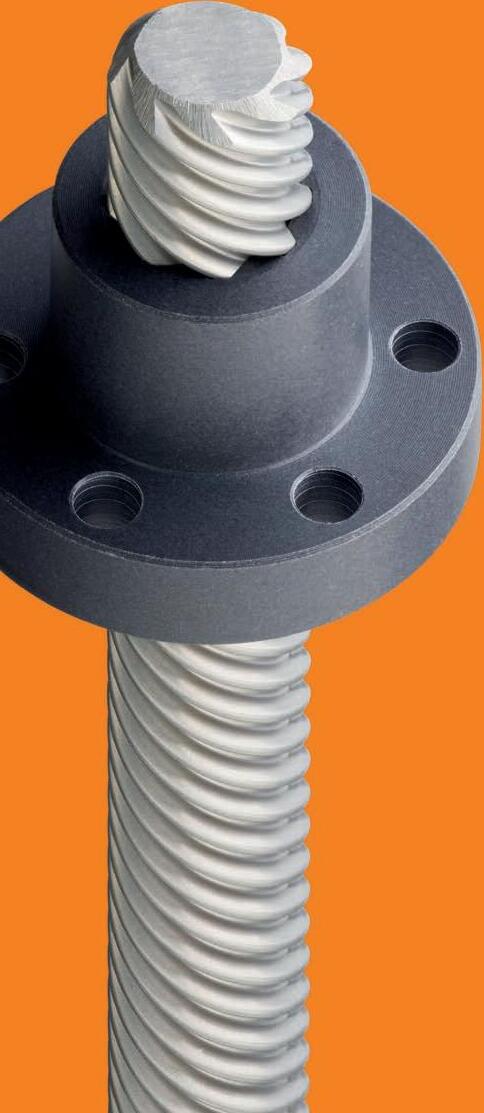




12 August 2023 www.designworldonline.com WORLD 8.23 • contents Insights Technology Forward Sustainable Engineering Design For Industry Design Notes DFAM Ad Index Technical Thinking Reduce noise and vibration over an extensive service life with dryspin®
and nuts 04 06 08 14 22 30 91 92 departments
Dry-running lead screws
EDITORIAL
VP, Editorial Director
Paul J. Heney pheney@wtwhmedia.com @wtwh_paulheney

Managing Editor
Mike Santora msantora@wtwhmedia.com @dw_mikesantora
Executive Editor
Lisa Eitel leitel@wtwhmedia.com @dw_lisaeitel
Senior Editor
Miles Budimir mbudimir@wtwhmedia.com @dw_motion
Senior Editor
Mary Gannon mgannon@wtwhmedia.com @dw_marygannon
Senior Editor
Rachael Pasini rpasini@wtwhmedia.com @WTWH_Rachael
Associate Editor Heather Hall hhall@wtwhmedia.com @wtwh_heathhall
CREATIVE SERVICES
VP, Creative Services




Mark Rook mrook@wtwhmedia.com @wtwh_graphics
Senior Art Director

Matthew Claney mclaney@wtwhmedia.com @wtwh_designer
Art Director
Allison Washko awashko@wtwhmedia.com
Senior Graphic Designer Mariel Evans mevans@wtwhmedia.com @wtwh_mariel
Graphic Designer
Shannon Pipik spipik@wtwhmedia.com
@wtwh_shannon
Director, Audience Development
Bruce Sprague bsprague@wtwhmedia.com

WEB DEV / DIGITAL OPERATIONS
Web Development Manager B. David Miyares dmiyares@wtwhmedia.com @wtwh_webdave
Senior Digital Media Manager Patrick Curran pcurran@wtwhmedia.com @wtwhseopatrick
Front End Developer Melissa Annand mannand@wtwhmedia.com
Software Engineer David Bozentka dbozentka@wtwhmedia.com
DIGITAL MARKETING
VP, Digital Marketing Virginia Goulding vgoulding@wtwhmedia.com @wtwh_virginia
Digital Marketing Manager Taylor Meade tmeade@wtwhmedia.com @WTWH_Taylor
Digital Marketing Coordinator Meagan Konvalin mkonvalin@wtwhmedia.com
Digital Marketing Coordinator Francesca Barrett fbarrett@wtwhmedia.com
Webinar Coordinator Emira Wininger ewininger@wtwhmedia.com
Webinar Coordinator Dan Santarelli dsantarelli@wtwhmedia.com
FINANCE
Controller Brian Korsberg bkorsberg@wtwhmedia.com
Accounts Receivable Specialist



Jamila Milton jmilton@wtwhmedia.com
EVENTS
Events Manager
Jen Osborne josborne@wtwhmedia.com @wtwh_jen
Events Manager
Brittany Belko bbelko@wtwhmedia.com
Event Marketing Specialist


Olivia Zemanek ozemanek@wtwhmedia.com
VIDEO SERVICES
Videographer Garrett McCafferty gmccafferty@wtwhmedia.com
Videographer Kara Singleton ksingleton@wtwhmedia.com
PRODUCTION SERVICES
Customer Service Manager
Stephanie Hulett shulett@wtwhmedia.com
Customer Service Representative
Tracy Powers tpowers@wtwhmedia.com
Customer Service Representative
JoAnn Martin jmartin@wtwhmedia.com
Customer Service Representative
Renee Massey-Linston renee@wtwhmedia.com
Customer Service Representative
Trinidy Longgood tlonggood@wtwhmedia.com
Digital Production Manager
Reggie Hall rhall@wtwhmedia.com
Digital Production Specialist
Nicole Johnson njohnson@wtwhmedia.com
Digital Design Manager

Samantha King sking@wtwhmedia.com
Marketing Graphic Designer
Hannah Bragg hbragg@wtwhmedia.com
Digital Production Specialist

Elise Ondak eondak@wtwhmedia.com
Dry-running lead screws and nuts



Reduce noise and vibration over an extensive service life with dryspin


DESIGN WORLD www.designworldonline.com August 2023 13 TOP WORK PLACES 2022 Follow the whole team @DesignWorld
Medical Design & OUTSOURCING
DESIGN WORLD
WTWH Media, LLC 1111 Superior Ave. 26th Floor Cleveland, OH 44114 Ph: 888.543.2447 2011 - 2020 2013 - 2017, 2021 2014 - 2016
Design for Industry
Hybrid hexapods deliver nanometer-level accuracy

Accurate motion control is crucial when manufacturing medical and clinical devices, such as diagnostic imaging machines and video endoscopes. Even the slightest deviation from specifications can make a device less e ective or hazardous.
Alio provides the Angulares Hybrid Hexapod for such applications. It uses sixaxis movement to shift the instrument without manual or robotic intervention. The Angulares exhibits low friction and particle generation, is easy to access and clean, and maintains the highest precision. Highly flexible programming enables 4K (and beyond) image quality, even using tiny and angled endoscopes.
“The Angulares features precision crossed roller bearing guides; optical incremental or absolute encoder feedback on all axes; linear motor or servo ball screw drives;
Medical 14 August 2023 www.designworldonline.com DESIGN WORLD
unlimited programmable tool center point locations and coordinate o sets; and zero backlash on all axes,” said Bill Hennessey, president of Alio. “The design makes the Angulares capable of unlimited XY travel; Z travel for 62 mm, which can be increased to 208 mm using other tripod models; tip/tilt travel of 60° (± 30°) with continuous 360° Theta-Z; XYZ bidirectional repeatability of less than ± 0.6 arcsec; velocity up to 100 mm/ sec XY and Z; and less than 10 nm linear and 0.1 arcsec angular minimum incremental motion.”
The Angulares is part of the Hybrid Hexapod family of motion control systems that addresses the inherent performance limitations of conventional hexapods. Alio’s patented 6-DOF design blends and takes advantage of the strengths of serial and parallel kinematic structures while avoiding their weaknesses. The Hybrid Hexapod o ers far greater functional versatility, nanometer-level accuracy, repeatability, and superior 6-DOF trajectories than is possible with any traditional hexapod or stacked stage configuration.
“Standard hexapods satisfactorily service applications where micron motion tolerances are required, but as the demand for nanometer requirements expands, standard hexapods struggle. This is due to performance limitations inherent in all ‘conventional’ hexapod designs. They operate within threedimensional space and have errors in all six degrees of freedom,” said Hennessey. “However, hexapod motion systems have typically only been characterized by performance data of a single degree of freedom. This practice leaves error sources unaccounted for in several degrees of freedom, especially in flatness and straightness, which are critical precision needs at the nanometer level required in many medical and clinical devices.”
The Hybrid Hexapod comprises a parallel kinematic tripod to deliver Z-plane and tip/tilt motion. This tripod is integrated with a monolithic serial kinematic stage for XY planar motion. A rotary stage integrated into the top of the tripod (or beneath, depending on application needs) provides 360° continuous (Theta-Z) rotation. In this hybrid design, individual axes can be customized to provide XY travel ranges from millimeters to virtually unlimited ranges while maintaining nanometer levels of precision. Novel forward and inverse controller kinematics provide unlimited programmable tool center point locations plus unmatched path precision and performance.
The 60° tip/tilt travel of the Angulares Hybrid Hexapod provides an ideal motion control system for medical and clinical device applications. It is also suited for aspheric and freeform optical metrology, silicon photonics packaging and probing, laser microprocessing (non-planar substrates and taper control), wafer metrology, camera module alignment and assembly, sensor/image stabilization testing, and optical element and fiber alignment. DW
POWER TRANSMISSION
RETAINING DEVICES & maintenance & assembly tools
DESIGN WORLD August 2023 15
Visit our website–whittet-higgins.com–to peruse the many possibilities to improve your assemblies. Much technical detail delineated as well as 2D and 3D CAD models for engineering assistance. Call your local or a good distributor. 33 Higginson Avenue, Central Falls, Rhode Island 02863 Telephone: (401) 728-0700 • FAX: (401) 728-0703 E-mail: info@whittet-higgins.com Web: www.whittet-higgins.com
WHITTET-HIGGINS manufactures quality oriented, stocks abundantly and delivers quickly the best quality and largest array of adjustable, heavy thrust bearing, and torque load carrying retaining devices for bearing, power transmission and other industrial assemblies; and specialized tools for their careful assembly.
WHITTET-HIGGINS USA
BEARLOK SHOELOK BEARLOK Shrink Disc
BEARHUG CLAMPNUT TANGENTLOK
PRECISION NUTS & WASHERS
ADAPTER SLEEVE ASSEMBLIES
NUTS & WASHERS HARDENED TONGUE WASHERS SPLIT COLLAR
LEFT HANDED
RIGHT -HANDED
of: CARBON, ALLOY and HARDENED ALLOY STEELS Materials of: ALLUMINUM and CORROSION RESISTANT STEEL
RETHREADING DIES ADJUSTABLE SPANNER WRENCH BEARING ASSEMBLY SOCKET
INCH
and METRIC THREADS
as well as
Materials
Alio Industries | www.alioindustries.com
Handling Design for Industry
Material
Safety sensors clear goods through the danger zone
Di erent material widths, varying material positions, or partially loaded pallets pose unique challenges for transfer station access guarding.
Access monitoring on conveyor lines can be implemented with classic tried-andtested safety concepts if the goods’ dimensions remain constant. Such concepts are mostly based on muting functions for automatic temporary bridging of the safety function. However, the application area for access guarding with muting functions is limited. If the goods’ width or position on the pallet or the pallet position on the conveyor varies, unmonitored safety gaps directly next to the goods can emerge. A person would then be able to access the danger zone. However, these gaps can be reliably closed with a tailored safety solution.
The following real-world examples illustrate the challenges of access guarding when pallets are automatically conveyed into or out of a danger zone using a conveyor line.
Example 1: The space next to the goods on the conveyor is larger than 200 mm.
Example 2: The goods have di erent widths, or the pallets are occasionally only partially loaded, resulting in open spaces greater than 200 mm next to the goods.

Example 3: The position of the goods on the conveyor varies, which also results in large gaps next to the goods. The reason could be due to o set pallet positions on the conveyor or a missing pallet centering device, depending on the application.
When muting is used, the goods activate the associated muting sensors in all three cases. The muting function then bypasses the protective function. However, it is not always possible to comply with the specified normative framework conditions for lateral safety distances (< 200 mm).
Leuze o ers a safety solution that closes these safety gaps: access guarding with dynamic format adaptation. This concept relies on a combination of safety sensors, measuring distance sensors, and the associated safety program. Two compact RSL 400 safety laser scanners are installed in the safety solution in front of the danger zone to safeguard the entry/exit point. Together they
16 August 2023 www.designworldonline.com DESIGN WORLD
create a vertical protective field with a high operating range of 8.25 m. Two optical distance sensors are also located in front of the protective field of the safety laser scanners on both sides next to the conveyor line. The distance sensors determine the goods’ width and indirectly determine their position on the conveyor line.










Based on the distance sensor information, the safety system releases a “clearance window” in the protective field corresponding to the goods’ width. After the goods have completely passed through the opened window, the system resets the protective field to its original closed state. If goods need to be fed in and discharged at one location, two additional distance sensors can be installed behind the protective field within the danger
zone. Thus, the safety system works identically in both conveying directions. The solution’s safety program monitors the entire process sequence, from distance measurement and protective field opening to resetting, and all configurations and parameters are individually adapted to the application requirements.
Another issue for these applications is how the safety system behaves in the event of a deliberate bypass attempt. A function extension is available for this scenario, and further risk minimization is often unnecessary, or the risk is already su ciently minimized by existing protective measures. In this case, it is worthwhile to conduct an applicationspecific risk assessment.
The Leuze safety solution for dynamic format adaptation overcomes












































































































































































































































































































































































































































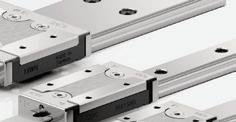
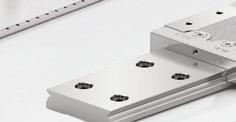











































the limitations of conventional muting concepts. Material width and position on the conveyor can vary without compromising safety. The safety solution reliably detects people walking sideways next to the goods and walking ahead or behind. Therefore, operators and manufacturers prevent dangerous situations while maintaining flexibility. Productivity is also increased, as the process requires no further protective measures, and the process in the danger zone can continue to run uninterrupted during material transfer. The safety solution is also easy to retrofit and provides optimum protection against deliberate or unintentional bypassing. DW

Leuze www.leuze.com
Design for Industry
Material Handling
New low-weight vacuum provides high-vacuum safety
While maintaining market-leading vacuum performance through its patented COAX technology, Piab’s new piSAFE program is best suited for challenging robotic applications and ergonomic handling devices where safety, flexibility, speed, and performance are critical. Whether an application needs a centralized or decentralized vacuum gripping system interfacing with common (industrial standard) EOAT systems or stand-alone mounting, the piSAFE program provides a high vacuum safety and highperforming configuration.
piSAFE program key benefits:
• Vacuum safety non-return valve (check valve) holds vacuum in sealed applications in case of a system or power failure.
• Available configurations are suitable for both centralized and decentralized vacuum systems.






• Can replace more expensive mechanical or vacuum-tank safety arrangements in robotic tools and ergonomic equipment.

• Suitable in robotic applications where high demand for safety is required.
• Suitable for ergonomic lifting devices/manipulators and cranes, which must comply with lifting norms such as (DIN/SS)-EN 13155 and ASME Standard B30.20.
• Through energy-saving features, noise levels and carbon footprint are reduced.
• Air consumption is reduced by up to 98% per cycle.
• Light-weight materials lower the weight for EOAT and ensure less wear on robotic motors and drive with a possibility for increased speed/acceleration or a smaller, cheaper robot.
piSAFE program key features:











































































• Configurable with vacuum ejectors based on COAX technology with integrated control functions for energysaving and release.
• Vacuum sensing port included for easy installation of the good-to-go switch.
• Configurable with di erent release functions supporting maximum release speed and air-consumption-free release.
• Configurable with multiple mounting options.
The modular design facilitates opportunities for easy maintenance and quick connect options and is fit for application configurations. DW
18 August 2023 www.designworldonline.com DESIGN WORLD
| www.piab.com
Piab






EtherNet/IP Modbus TCP ProfiNet FEATURES
DXMR110-8K Eight IO-Link Ports Multiprotocol Communication Lightweight Design 18-30 V DC Power 8x Total IO-Link Ports Powerful Edge Processing Built-in Status Indication AVAILABLE NOW Learn more about the New DXMR110-8K by scanning the QR Code
New IO-Link Master
Safety Design for Industry
HMI tablets get better ergonomic protection
Luiz Shida • IDEC Corporation
Dedicated human-machine interfaces (HMIs) and PCs, whether installed in a panel or a control room, have played an important role in providing robust operator interfaces for industrial applications. However, crewed equipment, robotics, and other manufacturing automation systems require hardwired safety provisions, such as emergency stop (e-stop) and enabling switches, in addition to digital interfaces. There is also a great need for flexibility so operators can access these HMI and safety features while moving around equipment, which fixed installations can’t provide.
Responding to the market need, IDEC developed the HT4P Safety Commander, an ergonomic device to hold and protect an HMI tablet. This new option allows designers to provide consumer mobile devices as high-performance HMIs with hardwiring and secure physical protection.
The original HT3P mobile device holder for industrial use remains available. It o ers some hardwired connectivity and relies on Bluetooth or Wi-Fi for wireless communications, which works well in many applications. Standard features include:
• Ability to use the tablet in vertical/portrait or horizontal/landscape orientations.
• Users can insert or remove the tablet at will or lock it into place for longer-term use.
• Suitable for left- and right-handed users, with a hand or shoulder strap to minimize fatigue.
• Availability of a wall-mount bracket.
• Rated IP54 for protection from water splashes, dust, and dirt, with an operating temperature of -10 to 35° C or more.

• Tested for drop resistance up to 1.2 m.
• Includes hardwired power, e-stop, and enable switch functionality.
The newest HT4P mobile device holder uses adjustable grippers with movable hooks and spacers, so larger tablets can be used while preserving access to power, audio buttons, and other ports. A new rotation unlock button ensures the tablet only rotates when the user wants it to, preventing unintentional operation.
Designers can still choose to use Bluetooth or Wi-Fi for their applications. However, in some environments — particularly those with high electrical noise — an onboard wired LAN connection is preferred for
faster and more reliable communications. The newer version incorporates a built-in LAN converter so that the USB tablet port can access a wired network.
The device incorporates two hardwired safety features. An e-stop button with an LED indicator and retrofittable guard to protect against unintended operation is available for connection with a standard equipment safety circuit. In addition, a three-position “o -on-o ” enable switch is essential for many equipment and robotics applications. The user must constantly grip this switch with moderate e ort for the equipment to run; however, if let go or squeezed too hard in a panic situation, the equipment will stop.
The newest mobile device holder now allows additional hardwired device functionality with three onboard mounting positions for standard or custom arrangements of pushbuttons, illuminated pushbuttons, selector switches, and keyed selector switches.
One inexpensive tablet can replace numerous industrial control panels, HMIs, and other buttons and lights. This new generation of mobile device holders provides more ways for OEMs and equipment designers to take advantage of modern and familiar tablets acting as HMIs located close to machinery. DW
20 August 2023 www.designworldonline.com DESIGN WORLD
IDEC | www.idec.com
Intelligent drives and electrification help modernize marine vessels
The marine industry is getting more intelligent, necessitating drives with built-in software capabilities and top-level computing power, including smart algorithms that provide superior speed, torque control, and accuracy. Danfoss recently debuted the iC7 Series liquid-cooled system modules that combine high power density, liquid-cooled thermal management, security, and easy system integration to deliver a drive that requires less room — for an industry where space is worth its weight in gold.
The iC7 Series liquid-cooled system modules deliver precision in motor control and modular control capacity. Secure by design, each drive is equipped with hardware-based protection against unauthorized access with a built-in crypto chip on the control unit. It uses a microSD card to copy settings, log data, download software, and activate additional features — all protected by the crypto chip, ensuring end-to-end encrypted data transfer.
In addition to next-generation drive technology, the Danfoss Vacon NX Series decarbonizes vessels through electrification. The product line o ers a complete range of dc/dc converters, drives, active front ends, and grid converters based on the same flexible and scalable platform.

Electrification saves on expensive diesel fuels, produces zero emissions, and decreases operating noise levels. Retrofitting older vessels
with new power systems can also help comply with many port and municipalities’ initiatives to reduce vessel carbon emissions and noise. For instance, Danfoss helped PortsToronto (the Toronto Port Authority) face the challenge of fully decarbonizing and retrofitting the formerly diesel-powered Marilyn Bell I ferry. The ferry was retrofitted with the Vacon NX Series and reduced direct emissions by approximately 530 tons per year.
The vessel makes four round trips per hour during a 19-hour day and recharges each time it docks at the mainland via an automated 400 kW pantograph charging system. This creates a shore-to-vessel dc connection that integrates with the Danfoss electrification system, utilizing the active front-end module to convert ac utility power to dc power for vessel system use. As soon as the vessel docks and the vehicle ramp lowers, the vessel starts charging via the pantograph, initiated using wireless communication between the vessel and onshore equipment.
From conception to installation, Danfoss’ Vacon Common DC-Bus electrification products made it possible for the Marilyn Bell I to be powered only by electricity from clean wind and solar sources, eliminating greenhouse gas emissions entirely. DW
Offshore Design for Industry DESIGN WORLD www.designworldonline.com August 2023 21
The iC7-Marine liquid-cooled system modules deliver ultra-compact drives with hardware-based security.
| courtesy of Danfoss
Danfoss www.danfoss.com
Boston Dynamics designed Stretch to be an autonomous mobile case-handling solution for unloading applications.
Mobile robots at the fore ont of intralogistics technology

 Edited by Mike Santora Managing Editor
Edited by Mike Santora Managing Editor
As s the intralogistics industry speeds ahead, mobile robotics will become even more critical. Many solutions move cartons and totes from point A to point B. Limitations arise when they lift cartons from conveyors or out of semi-trailers and shipping containers for palletizing and depalletizing. To better meet warehouse and distribution center requirements, Boston Dynamics developed an innovative robotic solution called Stretch. The autonomous mobile case-handling solution for unloading applications combines Boston Dynamics’ R&D with automation and integrated safety technologies from Beckho . Designed from the ground up to meet the needs of this industry, Stretch has a compact, highly maneuverable base that safely moves in any direction and navigates ramps or other obstacles. A perception mast uses computer vision for fast and precise case detection. What sets Stretch apart is its purpose-built robotic arm with seven degrees of freedom and adaptive vacuum gripper, which works with the perception system to manipulate the broadest possible set of cartons. A high-capacity battery option can power Stretch through two full shifts to support continuous, flexible unloading.
Stretch development team puts human safety first
Boston Dynamics had several goals for Stretch. The robot needed to o er the autonomy to intelligently react to changes in its environment and handling requirements, which is another key di erentiator in the market. It needed to extend the manipulation capabilities of Boston Dynamics’ other platforms to provide customer value in intralogistics. And it needed to provide the mobility to bring autonomy and manipulation capabilities from job to job throughout the day. But to achieve these capabilities with high system availability, the Stretch solution needed to provide robust safety capabilities to prevent injuries or damage.
“We had to find a solution that supported all the di erent types of sensors and safety features required for the robot and o ered reliable support for blackchannel safety communication protocols over Ethernet,” said Matthew Meduna, Technical Director of Hardware Engineering, Stretch.

www.designworldonline.com 22 DESIGN WORLD August 2023 Design
Notes
| Boston Dynamics, 2023
TwinSAFE leverages the trusted Fail Safe over EtherCAT (FSoE) standard, which is TÜV-certified, even enabling the passing of safety states over Wi-Fi in a hierarchical safety architecture. FSoE communicates safety data over the standard EtherCAT industrial Ethernet system using a black-channel approach. The advantages of EtherCAT — real-time communication, free selection of topology, up to 65,535 nodes on one network, extensive diagnostics, and more — are available to the safety system.
The TwinSAFE solution reduces cabling, hardwiring of safety switches, and management of di erent software packages, which helped simplify safety system implementation.


Stretch also gains an advantage using TwinSAFE SC (single channel) from Beckho . This enables the addition of standard analog signals for safe position and safe velocity of the mobile robot. TwinSAFE SC supports standard signals for both control and safety tasks, helping machinery achieve a safety level up to category 3, performance level d. Furthermore, specialized safety encoders are not required. Instead, standard encoders can be used with a full o ering of TwinSAFE SC encoder input signal
types, including SSI interface, Sin/Cos, EnDat 2.2, incremental encoder RS422 and incremental encoder 24V HTL.
Each Stretch robot has a CX5130 embedded controller inside, which monitors the system and communicates with a separate PC for fleet management. “The CX5130 determines if the robot is in a su ciently safe environment to allow motion, and it engages the power distribution zones and releases the brakes when requested by the controls software,” Meduna said. Along with several EtherCAT Terminals, TwinSAFE and TwinSAFE SC Terminals, including the EL1918, EL2912, and EL2904, handle safety functionality. These are critical for monitoring the joints of the robot arm and the speed and angles of the wheels. Two singlechannel encoder interfaces validate the accuracy of positioning data: EL50010090 for SSI and EL5101-0090 for incremental encoders with di erential signals (RS422) or TTL single-ended signals.
A remote fleet management panel ensures the safety of the overall work zone using a CX8190 embedded controller with a similar lineup of EtherCAT and TwinSAFE modules. These read inputs from E-stops, safety I/Os, cart or conveyor detection, and dock or shore cable detection.

TwinCAT 3 automation software from Beckho delivered an end-to-end engineering environment and runtime for the safety application. The Boston Dynamics team relied on TwinCAT for programming PLC and safety logic and used real-time Ethernet communication to talk UDP to other computers in the solution. With TwinCAT, engineers can program in the languages that they are most familiar with or that best fit the project, including the available IEC 61131-3 languages and their object-oriented extensions, function blocks, and computer science standards in Microsoft Visual Studio.
Mobile robot delivers ROI by the truckload





The commercial launch of Stretch occurred in early 2022 with clear di erentiators from other mobile robots on the market. Stretch can autonomously unload trucks and shipping containers and remains incredibly flexible. With a powerful vacuum gripper and advanced vision system, the robot handles various package types up to 50 pounds without requiring SKU number preprogramming or box size information. Going forward, Boston Dynamics plans to use wide-ranging Beckho technologies to best support unique customer applications, ensuring the utmost safety and reliability as robotics technologies evolve. DW
Going

23 DESIGN WORLD August 2023 www.designworldonline.com
| www.beckhoff.com 50
Beckhoff
A high-capacity battery option can power Stretch for up to 16 hours to support continuous, flexible unloading.
| Foreward LLC, 2023
The safety system for Stretch features EtherCAT I/O Terminals and yellow TwinSAFE functional safety modules both on the robot and in a remote cabinet.
| Foreward LLC, 2023
Setting the scene with rack and pinion systems
 Edited by Mike Santora • Managing Editor
Edited by Mike Santora • Managing Editor
When you attend a stage production, the performers are typically just one part of the show. Sometimes the components behind the scenes are just as important to a show’s success. That’s especially true whenever scenery or performers must be raised, lowered, or positioned safely and conspicuously. Elevators and lifts make it all happen, and almost any spectacular e ect is possible with creativity and engineering.
Specialized kinetic structures take the stage
Show Canada Industries is one of the world’s foremost fabricators of kinetic stage architecture. The company has built specialized structures for performance spaces, sports venues, and casinos in over 30 countries. Some of their most notable projects include the main ramp lift at the 2014 Olympic Games in Sochi and The Sun Kinetic Sculpture at the 2016 Olympic Games in Rio.
For many of its major projects, Show Canada uses Andantex gearing. The company typically employs racks and pinions inside its specialized elevators and lifts. According to David Boulay, Show Canada’s vice president of design and engineering, “Andantex products are reliable and give us a lot of precision and


speed.” Three such projects appear prominently inside the Rotunda Atrium at the Wynn Palace in Cotai, near Macau, China: the Iris Ceiling, the Dragon of Fortune, and the Tree of Prosperity. Here’s how they work:
The Iris Ceiling — This 65-ft diameter sculpted-dome ceiling is divided into 12 sections, or wedges, and each depicts a figure from the Chinese zodiac. When closed, they form a seamless ceiling over the atrium. The wedges open like an iris, revealing an LED screen that shows various scenes. The screen also opens to lower a 30-ft crystal chandelier.
Design Notes www.designworldonline.com 24 DESIGN WORLD August 2023
This 65-ft diameter sculpted-dome ceiling is divided into 12 sections, or wedges, and each depicts a figure from the Chinese zodiac.

Each 14,000-pound wedge has a built-in 7.5-horsepower gear motor and linear guide to move it into its open or closed position, along with an Andantex Module 4.0 Rack and Pinion. The motor holds the integrated pinion, while the rack is installed next to the track.


Dragon of Fortune and the Tree of Prosperity — For four minutes every hour, a 28-ft golden dragon sculpture with an animated head, glowing eyes, and a lotus blossom rotates amidst a rolling fog. A “jade-like” partial dome in the Rotunda’s floor opens, and the mechanical lift elevates the dragon sculpture into full view.
Relax.

The Dragon of Fortune alternates at 30-minute intervals with the Tree of Prosperity, a 36-ft diameter tree that ascends from the atrium floor as the crystal chandelier descends from the ceiling. This spinning tree consists of 60 limbs, 2,000 branches, and a combination of 98,000 gold and brass leaves which interact with video elements to depict the four seasons. Show Canada built a lift that shuttles back and forth between the Dragon of Fortune and the Tree of Prosperity via a wagon and trolley. Inside the lift, which can support up to a 42,000-pound payload, four Andantex rack and pinions — two Module 10.0 systems
Interpower® Offers

1-Week Lead-Times on North American, International Cords
In the electrical product consumer world, “return” isn’t usually a word manufacturers want to hear. Unless you’re referring to one of only two U.S. electrical cord manufacturers that returned to 1-week lead-times in late April of 2023.
Interpower 1-week lead-times began in 2008—our cords, cord sets, and components ship straight from the factory. Want them hanked, coiled, tied, bagged and individually boxed? Need 1-D or QR barcodes for easier warehousing? Customize lengths and colors for country-specific cords. In-stock cords ship the same day. Scheduled orders are also available.
DESIGN WORLD www.designworldonline.com August 2023 25 Toll-Free Phone: (800) 662-2290 E-mail: info@interpower.com Business Hours: 7 a.m.–5 p.m. CST Order Online! www.interpower.com ® ®























































Ministry of Foreign A airs and International Cooperation Learn how Italian companies are integrating advanced manufacturing technologies and equipment to empower North American manufacturing in the 15 TH edition of Machines Italia. machinesitalia.org Find Machines Italia Magazine Here: issuu com/wtwhmedia/docs/machines italia volume _ xv _ 2023 ADOBES TOCK (2), LEONARDO’S VITRUVIAN MAN ILLUSTRATION: TOMASZ RZYMKIEWICZ
Design Notes


Designed to deliver troublefree operation over a long lifetime, the rack and pinions are especially appealing for specialized applications like theatrical lifts and other kinetic architecture.


per column — are at the heart of the linear drive systems. The drive systems also link together four 180-horsepower motors with gearboxes, and each motor provides between 38 and 41 rpm and 372,000 pounds-inch of torque.
The rack and pinions easily meet the speed requirement for raising and lowering the Dragon of Fortune and Tree of Prosperity sculptures — three feet per second.
Designed to deliver trouble-free operation over a long lifetime, the rack and pinions are especially appealing for specialized applications like theatrical lifts and other kinetic architecture. Compared to other technologies such as wire rope, roller chains, and push
chains that typically must be replaced within ten years, the rack and pinions usually last up to 20 years in Show Canada equipment and often outlast the life of the production.

Andantex rack and pinions are available in straight or circumferential pitch versions and o er an exceptional combination of power and precision. With their modular design, rack segment lengths from 0.5 to 2 meters can be linked together end-to-end so users can achieve any desired travel length from standard components. DW
Ease your mind with 1-week lead-times on power cords and cord sets. Customers can even lock in prices and have their North American and international power cord sets shipped on predetermined schedules throughout one calendar year—cords when and where you need them.
Interpower cord sets ship straight from the factory. Want them hanked, coiled, tied, bagged and individually boxed? Need 1-D or QR barcodes for easier warehousing? Customize lengths, colors, packaging and labeling for country-specific cords. In-stock cords ship the same day.

Andantex www.andantex.com DESIGN WORLD www.designworldonline.com August 2023 27 Toll-Free Phone: (800) 662-2290 E-mail: info@interpower.com Business Hours: 7 a.m.–5 p.m. CST Order Online! www.interpower.com ® ®
Resistance— Interpower® 1-Week Lead-Times
The Supply Chain Path of Least
Where OT and IT meet
Edited by Mike Santora • Managing Editor
The worlds of information technology (IT) and operational technology (OT) in manufacturing plants have traditionally functioned independently. The goal of OT was to keep the plant running smoothly while IT managed all the business applications within the enterprise. But with the explosion of the Industrial Internet of Things (IIoT), these two technology worlds are rapidly uniting. Integrating these two worlds — what’s known as the IT/OT convergence — is no easy feat. Fortunately, new solutions are beginning to bridge the gap between IT and OT, taking smart manufacturing to new heights.




Implementing a defense in depth security plan









Traditionally, IT and the OT departments have di erent priorities regarding security, making education and communication between the two teams critical — especially when it comes to building the future of industrial networking. For example, it’s important for the OT department to understand and implement key concepts that the IT department has already been using. Embracing a Defense in Depth (DiD) strategy, in which multiple layers of security controls are placed throughout an IT system, can increase the security of a network or application. DiD works by adding
multiple layers of protection — virtual local area networks (VLAN), firewalls, and strict user access control — from attacks. Increasing network and application security by implementing a DiD strategy can help align the IT and OT teams and create a more robust application. One way to get started is to build zones and conduits using VLANs, routers, and monitored access control. For the hardware, you only need layer 2 Ethernet switches to create the VLANs. Then, using routers and firewalls, you can build a path in and out of these smaller zones. It’s also important to implement access control and some type of monitoring and alerting. Often, you can

28 August 2023 www.designworldonline.com DESIGN WORLD Design Notes
| AdobeStock.com | panuwat
use access control lists, allowing access based on the IP or MAC address of a network device. The network should also log and alert administrators when unusual activity is detected, ensuring control engineers have as much time as possible to take action and mitigate downtime.
One current technology many IT departments are already using is Syslog, a standard for message logging that separates the software that generates, stores, and reports the messages. Many industrial control products support this feature, including the FlexEdge Intelligent Edge Automation Platform and NT24k Ethernet switch.
Breaking down barriers with software at the edge
Successful IT and OT integration will depend on enterprise connectivity solutions between the systems that create the data and the users that consume it. Industrial organizations have a lot of operational data — but they often don’t know how to take advantage of it at the enterprise level to improve their operational resiliency, sustainability, and supply chain agility. And although many digital transformation initiatives are on the rise in manufacturing, the fact that many companies still struggle to make OT and IT play nicely with each other prevents them from tapping into the hidden insights in all their industrial data sources.
A key reason for these roadblocks is the lack of proper correlating context, such as the data source, type, or timestamp, while capturing OT data at the network edge or device level. Without this critical OT context, the captured data has low data integrity, driving up the time and e ort it takes to prepare the data to build analytical

models. To extract any actionable insights from this OT data, it must be packaged in an interchangeable and flexible format that can be easily shared between OT and IT applications.
This is the future of IT and OT integration — connecting data as it is being generated in real-time to the analytics engines, quality systems, traceability records, and optimization programs that drive industrial e ciency.

Already, new technology developments at the edge are helping to break down the barriers between the systems that create the data and the consumers of the data. Once the data can flow easily, data scientists can create actionable industrial performance insights. Software that collects, organizes, and contextualizes OT data — and then makes it available to higher-level IT applications and databases — can unlock actionable plant- and enterprise-level insights to accelerate IIoT transformation.
So what do these devices, designed to function at the intersection of OT and IT, look like? For one, the device should either be an IT device with OT features or an OT device with IT features. It should also integrate the following capabilities:
• An ability to connect to built-in sensor networks connected to PLCs or controllers.
• An ability to connect directly to sensors or to brownfield devices, modern PLCs, industrial switches, and operator panels.
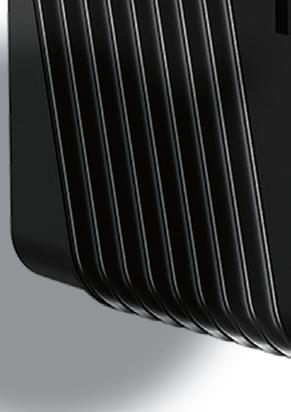

• Alarms that can be configured to alert users of out-of-bounds conditions.


• An ability to securely access data and assets over virtual private networks (VPN). DW

29 DESIGN WORLD August 2023 www.designworldonline.com
FlexEdge Intelligent Edge Automation Platform.
Lion www.redlion.net
Red
Security concerns, and a need to contextualize OT data for higher-level IT use, are some common challenges for IT/OT convergence.
| AdobeStock.com
| Aliaksandr Marko
Design for 3D printing and Additive Manufacturing
Salzburg University Hospital performs groundbreaking surgery with

orthopedic AM
Salzburg University Hospital created 3D models from the patient’s CT images to design the patient-specific occipital prosthesis. | courtesy of Salzburg University Hospital

The University Hospital of Salzburg in Austria
successfully designed and produced its first 3D-printed polyetheretherketone (PEEK) cranial implant using 3D Systems’ point-of-care additive manufacturing technologies. The hospital used Oqton’s D2P software to create 3D models from the patient’s CT images and Oqton’s Geomagic Freeform to complete the design of the patient-specific occipital prosthesis. The cranial implant was printed using Vestakeep i4 3DF PEEK by Evonik on 3D Systems’ Kumovis R1 extrusion platform.
PEEK is a desirable material for medical device production because it is lightweight, resistant to thermal and ionizing radiation, and possesses mechanical properties like human bone. The Kumovis printing platform was specifically designed to enable this type of point-of-care application within the hospital.


30 August 2023 www.designworldonline.com DESIGN WORLD
• • • • • • • • • • • • • • • • • • • • • • • • • • • • • • • • • • • • • • • • • • • • • • • • • • • • • • • • • • • • • • • • • • • • • • • • • • • • • • • • • • • • • • • • • • • • • • • • • • • • • • • • • • • • • • • • • • • • • • • • • • • • • • • • • • • • • • • • • • • • • • • • • • • • • • • • • • • • • • • • • • • • • • • • • • • • • • • • • • • • • • • • • • • • • • • • • • • • • • • • • • • • • • • • • •
In-house clinicians combined Oqton’s D2P and Geomagic Freeform software with 3D Systems’ Kumovis R1 to produce a patient-specific cranial implant.
The patient, Rainer Trummer, a 55-yearold computer scientist from Salzburg, su ers from craniosynostosis, where one of his cranial bones ossified too early during childhood, resulting in a skull deformation. While searching for help, Tummer turned to Professor Alexander Gaggl, head of the Department of Oral and Maxillofacial Surgery at the University Hospital of Salzburg, who decided on a spectacular treatment that would take months to complete.
“We planned to replace the visually missing occiput with a prosthesis,” said Gaggl. “However, we faced the challenge that the scalp is very taut and hardly stretchable.”


Last year, Trummer had a plastic balloon implanted under his scalp and 250 mL of saline solution pumped into it over six months. When 3D printing became an option, in-house clinical engineers manufactured a PEEK implant in 10 hours. On February 10, 2023, a few days before Trummer’s 55th birthday, Gaggl and Senior
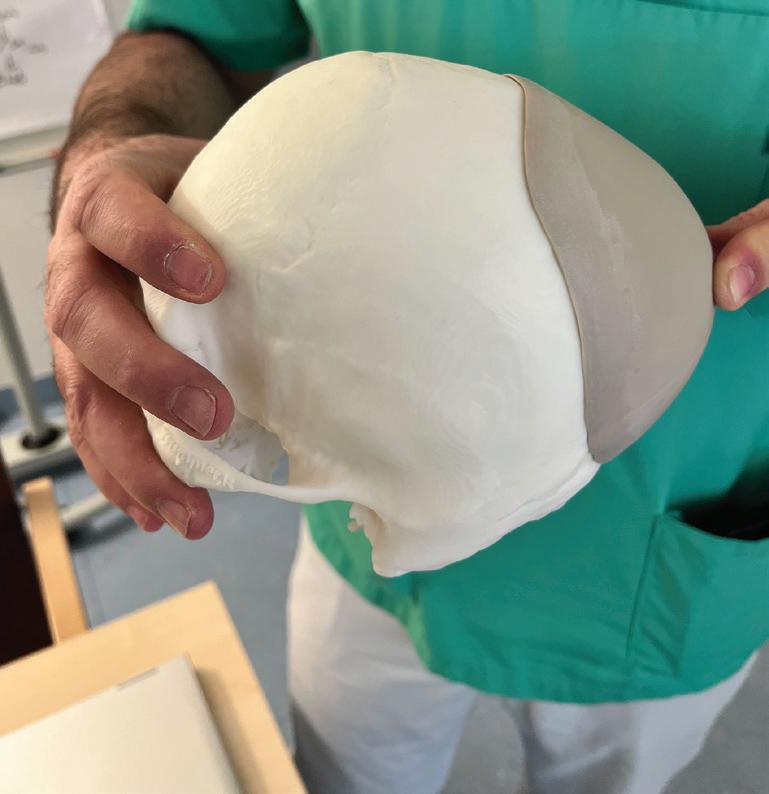
versatile
used with our









for fast, accurate motor encoder alignment.

Let our engineers assist in your sensor design. Utilizing our own silicon foundry, we fabricate our own photodiodes. Then we build from the ground up, with design and manufacturing on-site providing for application-specific products.




DESIGN WORLD August 2023 31 High Performance Incremental Encoders QM35 Low Profile QM22 Small Diameter 608.924.3000 quantumdev.com Better Design. Better Performance. Made in Barneveld, WI USA Visit our online store. All orders ship within 48 hours. Quantum Devices’ QM35 and QM22 are bearingless, modular encoders ideal for high volume OEM applications and competitively
for all sizes of motion control projects. Both models offer
electrical
allowing for customization and can be
QC201
Indicator
priced
configurations
Commutation
| courtesy of Salzburg University Hospital
Physician Simon Enzinger performed the procedure in six hours — a comparatively short time.












“We fixed the implant to the top of the skull with four plates and eight screws,” said Enzinger with a grin. “It holds bombproof!”
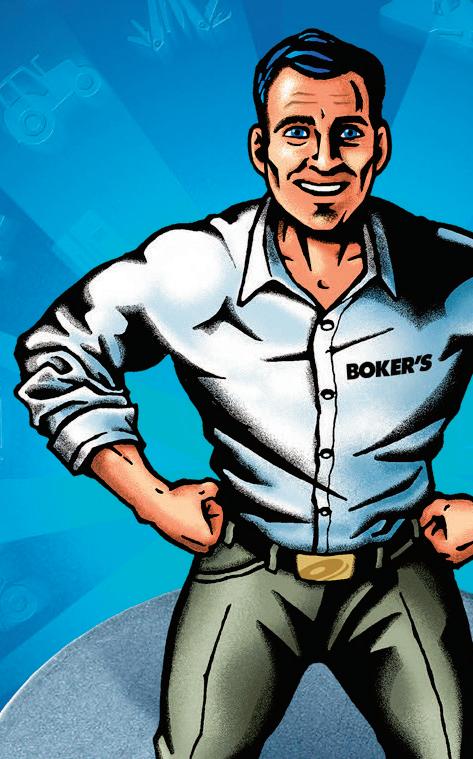
Six weeks later, the surgical wounds largely healed.
“I’m doing great; I’m totally happy!” said Trummer. “I don’t feel like I have an implant in my head, but now I have a completely ‘normal’ head. It’s like a miracle for me.”


The 3D printing lab is part of the University Hospital of Salzburg’s digitization strategy it has consistently pursued since the COVID-19 pandemic onset.






“We wanted to take with us the positive momentum that the pandemic triggered in this area,” said lecturer Paul Sungler, managing director of the University Hospital Salzburg and an experienced surgeon. “We stand for digitization in the interest of patients, and 3D
Rainer Trunner stands next to the Kumovis R1 that produced his 3D-printed cranial implant. | courtesy of Salzburg University Hospital

32 August 2023 www.designworldonline.com
THE RIGHT STAMPING. THE RIGHT WASHER. RIGHT NOW. bokers.com (800) -WASH ERS BOKER’S WILL BE THERE. For over 100 years, nearly every industry across the globe has trusted Boker’s to provide quality components, world-class service and fast delivery. SUBMIT YOUR PART SPECS & Get a Fast Quote
Design for 3D printing and Additive Manufacturing
printing and its many clinical application possibilities are a central building block here.”


3D-printed cranial implants are expected to accelerate alongside technological advancements. Acumen Research and Consulting recently reported that the cranial implants market size in 2021 was roughly $1.2 billion and is anticipated to approach $2.1 billion by 2030. Cranial implants can address many applications, including trauma, defects, and reconstruction. Advances in technology — including materials and manufacturing methodologies such as 3D printing — are anticipated to provide new solutions to help drive growth in this market.
“We are thrilled for Mr. Trummer and the relief this procedure has given him, and deeply indebted to the talented surgeons and sta at Salzburg University Hospital who brought together for the first time our unique software, hardware, and materials technologies in a point-of-care hospital setting to address his specific needs,” said Je rey Graves, president and CEO of 3D Systems. “We believe that this success provides a real-life demonstration of the potential for enhancing orthopedic outcomes using comprehensive digital manufacturing technologies in a hospital setting. Our focus on the point-of-care implementation of these integrated technologies is a key priority for our company and one that we believe will bring significant benefits to patients around the world in the years ahead.”
As a pioneer in personalized healthcare solutions, 3D Systems has worked with surgeons for over a decade to plan more than 150,000 patient-specific cases. The company has additively manufactured more than two million implants and instruments for 100+ CE-marked and FDA-cleared devices from its world-class, FDA-registered, ISO 13485-certified facilities in Littleton, Colorado, and Leuven, Belgium. DW

DESIGN WORLD August 2023 33
• • • • • • • • • • • • • • • • • • • • • • • • • • • • • • • • • • • • • • • • • • • • • • • • • • • • • • • • • • • • • • • • • • • • • • • • • • • • • • • • • • • • • • • • • • • • • • • • • • • • • • • • • • • • • • • • • • • • • • • • • • • • • • • • • • • • • • • • • • • • • • • • • • • • • • • • • • • • • • • • • • • • • • • • • • • • • • • • • • • • • • • • • • • • • • • • • • • • • • • • • • • • • • • • • • • • • • • • •
3D Systems | 3dsystems.com
7 Reasons to Consider Swapping Your Pneumatic and Hydraulic Actuators for Electric Cylinders
Introduction
For decades, pneumatic and hydraulic actuators have been goto technologies in the industrial automation space, but they have as many drawbacks as advantages, particularly pneumatic actuators. Meanwhile, electric cylinders have made great strides, to the point where OEMs and system integrators are increasingly choosing them whenever possible. Compared to pneumatic and hydraulic technologies, electric cylinders offer significantly higher efficiency and positioning performance, as well as reduced maintenance and downtime in a smaller package. The result is the lowest total cost of ownership (TCO) of the three technologies.
With ongoing technical advances, electric cylinders can generate forces that are competitive with pneumatic actuators and with a percentage of hydraulic actuators. For industrial applications, pneumatic and hydraulic cylinders should no longer be considered a given. Let’s look at seven reasons why you should consider electric cylinders for your next project.
Cylinder basics
The common terminology is to call pneumatic and hydraulic actuators cylinders, but that’s incorrect. These are actually system-level solutions:
Pneumatic Actuators: Pneumatic actuators generate motion through compressed air. A typical pneumatic actuator consists of an air cylinder, a compressor or compressed-air supply, hoses, and ancillary devices like seals, valves, regulators, filters, etc. Single-action cylinders use compressed air for a single direction and a spring for the return. Double action pneumatic cylinders use compressed air for both extension and retraction.
Hydraulic Actuators: Hydraulic actuators use a similar model to pneumatic actuators, except that instead of transferring force via compressed air, they use a non-compressible hydraulic fluid. The actuator consists of a hydraulic cylinder, a pump, a fluid reservoir, ancillary filters, etc.
Electric Cylinders: Electric cylinders use an electric motor to drive a rod-style actuator (see Figure 1). Outside of the motor drive and feedback device (typically an encoder), they just need cabling to operate. Electric cylinders provide a number of advantages over pneumatic and hydraulic actuators.
Reason #1: Higher Efficiencies
One of the biggest drawbacks to pneumatic and hydraulic actuators is that the compressors or pumps need to run constantly to keep the lines charged, even when the cylinders are idle. Pneumatic actuator efficiencies range from 10% to 25%, although that number drops over time as seals degrade and leaks develop in the supply hoses. Hydraulic actuators are a bit better at roughly 40% efficiency.
www.designworldonline.com 34 DESIGN WORLD August 2023 ADVERTORIAL
In contrast, electric cylinders draw power only when the motor is turning to move the cylinder. As a result, they can achieve efficiencies as high as 80%, for a substantially lower energy consumption than the other two technologies. This is an important point, particularly since the lifetimes of industrial assets are expected to be measured in decades. A pneumatic actuator can have a lower total cost of acquisition (TCA) than an electric cylinder, but an electric cylinder will have a significantly TCO over the life of the product.
Reason #2: Increasing Force
The thinking used to be that hydraulic cylinders offer the most force, followed by pneumatic cylinders, then electric cylinders. That situation has changed.
Advanced electric cylinders like the AA3000 can produce peak forces as high as 25 kN (see sidebar). That’s a match for any pneumatic actuator. Electric cylinders are not being positioned as a blanket replacement for all hydraulic actuators, but they are viable options in a significant percentage of cases, especially given the other capabilities they bring such as…
Reason #3: Better Accuracy, Repeatability, and Resolution
Electric cylinders deliver full servobased motion control functionality. They offer high accuracy and repeatability; resolution depends on feedback and the mechanical fidelity of the system. Electric cylinders can direct the load to any position across the length of stroke and support complex

Meet the AA3000 Electric Cylinder from Beckhoff
z Peak forces from 6.5 kN to 25 kN
z Stroke lengths from 150 mm (5.9 in) to 250 mm (9.8 in)
z Direct drive, with no belt or gearbox; backlash of 15 µm
z ISO 15552 compatible for a direct drop-in replacement of pneumatic and hydraulic systems
z Auto configuration – just scan the nameplate
z Integrated safety encoder with 17 different safe motion functions
z Integrated temperature and current monitoring for predictive maintenance
35 DESIGN WORLD August 2023 www.designworldonline.com
Figure 1: An electric cylinder, like the Beckhoff AA3000, consists of an electric motor driving a threaded rod-style actuator.
acceleration profiles. Backlash depends on the mechanical elements of the system, particularly the gearbox, but is consistently better than pneumatic actuators.

Pneumatic and hydraulic actuators can only position accurately at the extremes of stroke. Mid-stroke positioning requires servo valves that add complexity and cost without meeting the accuracy, repeatability, and resolution of electric cylinders. Any leakage of seals and hoses as equipment ages will compromise performance and require constant adjustment. Changing velocity is extremely challenging.
Because pneumatic actuators use compressed air, there’s a certain amount of compliance, or sponginess, when they’re back driven. Hydraulic fluid is non-compressible, so hydraulic
actuators don’t suffer from this issue. Electric cylinders can have backlash, but only on reversal and it is generally well-controlled – for the AA3000, it can be as low as 15 µm.
Reason #4: Lower Maintenance
Pneumatic and hydraulic actuators are multi-part systems that are labor-intensive to maintain. Hoses leak, seals degrade, and the pumps and compressors themselves require maintenance. Although the induction motors that power compressors and pumps can be monitored through vibration analysis, advance warning systems for issues like leaks in hoses is more difficult. In the case of pneumatic cylinders, leaks significantly increase power consumption while compromising performance, but troubleshooting
can be very time-consuming. In the case of hydraulic actuators, the leaks will be very obvious –and very messy. In both cases, maintenance teams can spend a large amount of time inspecting the system in an effort to maintain performance, which can be very expensive. There is also the ever-present task of cleaning up leaking hydraulic fluid.
Electric cylinders have far fewer points of failure – no hoses, valves, flowmeters, compressors, pumps, etc. Although there is a seal around the rod of the actuator, it is not directly related to system performance and doesn’t impact accuracy, repeatability, or power consumption. Electric cylinders track position using encoders, which are much more robust and reliable than the mechanical devices like reed switches that are used by pneumatic and hydraulic actuators. Even better, electric cylinders have well-established predictive maintenance capabilities that give advance warnings of developing issues, making it possible to schedule maintenance at convenient times.
www.designworldonline.com 36 DESIGN WORLD August 2023 ADVERTORIAL
Figure 2: Streamlined configuration software for the AA3000 makes motion profile selection as easy as point and click.
Reason #5: Greater Ease of Use
Pneumatic and hydraulic positioning is based on fluid flow, so initial set up and commissioning can be timeconsuming and complex. Electric cylinders are software controlled. Their reputation for complexity is outdated – many industrial systems feature auto configuration and streamlined user interfaces for fast commissioning (see Figure 2). For OEMs and system integrators assembling a machine, time is money. Commissioning speed is an important advantage for end users as well.
Electric cylinder technology really shines when it’s time to change motion parameters. For pneumatic and hydraulic actuators, the process of calculating pressures and adjusting (and adjusting, and adjusting…) valves to achieve the desired position and velocity begins all over again. In the case of electric cylinders, changeovers just require a software update, or choosing a different recipe from the HMI menu.
Electric cylinders also simplify machine safety implementation. Pneumatic and hydraulic cylinders require external sensors and relays, which can be complex, expensive, and time-consuming to implement, while further increasing the footprint of the system. Electric cylinders are now available with integrated safety capabilities that can be implemented with simple configuration screens.
Reason #6: Smaller Footprint
Electric cylinders have a smaller footprint than pneumatic or hydraulic actuators that have the same force rating. They don’t need compressors or pumps, or the sometimes-extensive supply hoses required by pneumatic and hydraulic solutions. Some electric cylinders may have external drives either on the machine or in a cabinet, but versions with integrated motors, like the Beckhoff AA3000, are increasingly common.
Reason #7: Lower TCO/Faster ROI
The combination of higher efficiencies, reduced maintenance, and better ease-of-use add up to lower TCO for electric cylinders. In high force applications, electric cylinders deliver faster ROI than pneumatic cylinders.
Conclusion
Modern electric cylinders provide a host of advantages over pneumatic actuators and many hydraulic actuators. With increased efficiency and ease
of use, along with reduced maintenance requirements, electric cylinders offer users significantly lower TCO. Meanwhile, electric cylinders also deliver vastly better performance than the alternatives, with complete motion control capabilities and higher accuracy, repeatability, and resolution. Just as important, continued technology advances have resulted in electric cylinders capable of peak forces as high as 25 kN. To this, add a smaller footprint – always a consideration in the crowded factory environment – to the host of reasons to consider electric cylinders for your next application.
To learn more about the Beckhoff AA3000 electric cylinder and what it can do for you, contact

37 DESIGN WORLD August 2023 www.designworldonline.com
sales.usa@beckhoff.com
890-0000
(952)
www.beckhoff.com/AA3000
Absolute encoders–
facts and misconceptions
A little knowledge goes a long way — knowing and understanding the advantages and limits of encoders and limit switches can ensure the best possible motion system design.
Ray Marquiss | Senior Application Engineer for Automation Valin Corporation
There are two parts of motion control systems often overlooked or misunderstood; encoders for either the motor rotation or the actual position of the actuator, and the limit and home sensors used for mechanical safeguarding and positional orientation. Encoders are ubiquitous on nearly all motion for industrial applications. Home and limit sensors are also used for almost every application. However, in an e ort to limit cost or perceived complexity, machine builders may determine that the use of a home sensor and in some cases, limit sensors, is not required. They either mistakenly rely only on the encoder or don’t understand the encoder they are using.
There are two basic types of encoders customarily employed for motion control applications. The first
and, until recently, most common type is the incremental encoder. The other is the absolute encoder. Both are similar in as much as they keep track of motor rotational position by basically counting pulses.
These pulses are fed back to the motion controller to confirm the position of the actuator. These pulses can be scaled into engineering units in the motion controller so that positions can be displayed and entered in easily understood units.
It's customary for most applications to have sensors in at least three di erent positions on the actuator; one at a known mechanical position used to align

Motion Control • • • • • • • • • • • • • • • • • • • • • • • • • • • • • • • • • • • • • • • • • • • • • • • • • • • • • • • • • • • • • • • • • • • • • • • • • • • • • • • • • • • • • • • • • • • • • • • • • • • • • • • • • • • •
www.designworldonline.com 38 DESIGN WORLD August 2023
Sizing and selecting the best mechanical solution for an application, especially where multiple axes are required such as in gantry systems, involves many design details and components, including encoders and sensors.

• • • • • • • • • • • • • • • • • • • • • • • • • • • • • • • • • • • • • • • • • • • • • • • • • • • • • • • • • • • • • • • • • • • • • • • • 39 DESIGN WORLD August 2023 www.designworldonline.com
Motion Control
For industrial applications that require absolute positioning output, the Encoder Products Model 925 single turn absolute encoder o ers fully digital output and Opto-ASIC technology. Available with either round servo or square flange mounting, and a variety of connector and cabling options, it can easily be designed into a variety of application requirements. The wide selection of shaft sizes supported by industrial grade, heavy duty bearings, and optional IP67 seal, make it suitable for tough environments.
the motor encoder and the motion controller position, and one at each end of the actuator’s limit of travel. These are typically referred to as the “home” or “origin” sensor and the “limit” sensors (positive limit and negative limit).

Absolute vs. incremental encoders







It’s also important to understand the di erences between absolute and incremental encoders. Both types report their positions back to the motion controller in a similar fashion. Technically, it’s done by di erent types of signals, but the end result is the same in the motion controller. The important distinction is how and when the “home” or “origin” position is established. With incremental encoders, a mechanical home position is established after a
power cycle, most often by moving to the home sensor. In a home-search procedure, the actuator is moved slowly until the home sensor detects it. Then, the motion controller sets its position counter to a known value, most often zero. From this point on, the position is tracked using data received by the encoder as the actuator is moved. A power cycle or crash would necessitate performing the homesearch procedure again.
With absolute encoders, the mechanical home position is found the same way it is with an incremental encoder. The di erence is that one of several methods is used to back up the encoder so that a power cycle or crash does not force performing a homesearch procedure again. Therefore, the procedure is usually only done once when the machine is commissioned. Whether absolute or incremental encoders are used has nothing to do with making absolute and incremental moves from the motion controller, nor does one inherently provide better accuracy.

Before continuing with how the limit and home sensors work with the

encoder, it’s important to note a few things about absolute encoders; their advantages, and the way their values are backed up. Absolute encoders can o er substantial time savings on machine with long actuators (say, 1 m or more) because the home-search routine is typically slow, with the actuator moving at less than 100 mm per second while it tries to find the home sensor. With absolute encoders, the homesearch procedure can be skipped, and machine operation can start more quickly after a power cycle because that important position information is backed up during a power cycle.
The method used for backing up absolute encoders has been traditionally done by batteries. A battery either connected to the amplifier or inline with the encoder cable connected to the motor is used to keep enough power to the encoder so that it will be able to hold the position information during power cycles. The home-search
The Model 725 2.5-in. Accu-Coder from Encoder Products is an optical shaft encoder specifically designed for the challenges of an industrial environment o ering resolutions up to 30,000 cycles per revolution. The Model 725 o ers both flange and servo mounting options, and is available in two housing styles.


www.designworldonline.com 40 DESIGN WORLD August 2023
• • • • • • • • • • • • • • • • • • • • • • • • • • • • • • • • • • • • • • • • • • • • • • • • • • • • • • • • • • • • • • • • • • • • • • • • • • • • • • • • • • • • • •
slowly
a crash
routine is done once, typically when commissioning the machine, and then not needed again. That is, it’s not needed until the battery goes dead and the encoder information is lost. That’s a disadvantage to the absolute encoder.












Manufacturers have addressed the battery problem in recent years by finding ways to store the position data without the use of batteries. There are a few ways to accomplish this, but the operation of and information from the encoders is the same regardless of how the battery is eliminated. Now the machine builder can take advantage of the benefits of an absolute encoder without worrying about the battery dying. In addition, the price of motors with absolute encoders has been steadily going down to the price point of motors with incremental encoders.

In fact, many suppliers o er motors or actuators only with battery-less absolute encoders now.









There is another benefit of using absolute encoders without a battery though. Machine builders are often under pressure to create custom machines in a tight timeframe. Often when absolute encoders are used, they don’t get around to creating the procedure for an easy “re-homing” to initialize the absolute encoder after a battery goes dead. Many times customers who found that their machine no longer knows where it is because the battery went dead, and there was no procedure programmed into the HMI and controller to help make the replacement of the battery and rehoming easy, leading to lost productivity while they figured it out.
Limit switches
Limit switches are usually near the end of the actuator’s stroke limit in case something goes wrong, and the motion controller doesn’t have accurate position data. This might occur if the machine has an incremental encoder and can be jogged before a homesearch. The limit switches work with the motor amplifier or motion controller to make the motor stop in the direction of travel if the limit switch signal is activated (usually if it goes OFF). This simple function can eliminate machine damage from slamming into the hard stop at the end of an actuator at a high speed.
One of the practices to discourage is when design engineers want to save a little money or complexity and simply have one sensor on their







• • • • • • • • • • • • • • • • • • • • • • • • • • • • • • • • • • • • • • • • • • • • • • • • • • • • • • • • • • • • • • • • • • • • • • • • • • • • • • • • • • • •
Compression Springs www.DiamondWire.com Torsion Springs Extension Springs 1-800-424-0500 MADE IN USA MILLIONS of Springs IN STOCK AND READY TO SHIP! LINE SHAFT CONVEYOR BELTS Original Equipment and Connectable CUSTOM MADE IN INCH, METRIC & O-RING SIZES • Round, Flat and Connectable Polyurethane Belts • Very Clean Operation • Eliminates Tensioning Devices • Exceptional Abrasion Resistancexxxxxxxxxxxxxx pyramidbelts.com POWER TRANSMISSION-PART CONVEYING PYRATHANE® BELTS Lifetime Warranty Against Manufacturing Defects AN ISO 9001 CERTIFIED COMPANY 641.792.2405 sales@pyramidbelts.com
Conveyors










































actuator because they are using absolute encoders. The thinking is that this sensor will be used for the home sensor during the initialization of the absolute encoder on the first use. Afterwards, they think there is no need for limit switches because the machine knows where it is, and “soft limits” can be set to make sure that the operator or operation doesn’t move past those limits. However, experience shows that the cost of the home and limit sensors is more than recouped by the time saved when using an absolute encoder. If minutes are saved during every power cycle of the machine, the price of those switches is negligible. Besides, they provide redundancy for unexpected situations that can arise, and things can happen that will defeat any encoder’s ability to report the correct position back to the motion controller. A loose coupling on the connection between the motor shaft and the actuator shaft, for instance, could lead to a situation where the actuator is not where the motion controller thinks it is because the motor will get out of synch with the actuator in this case.
If you’re designing a new motion control application and are considering the basic elements for that control (the encoder and sensors), don’t cut corners. The cost and complexity of absolute encoders, and the benefits of using them, is such that they should be considered the standard for the position feedback. At the same time, adding simple, low-cost sensors for the home and limit positions adds so little cost to the application and provides benefits that pay back the expense, so they should be included every time. DW













42 August 2023 Motion Control • • • • • • • • • • • • • • • • • • • • • • • • • • • • • • • • • • • • • • • • • • • • • • • • • • • • • • • • • • • • • • • • • • • • • • • •
Valin Corporation www.valin.com
Seamless Conveyance in Industrial & Sanitary Applications Gentle Product Handling Smooth Transfers Increased Throughput
Precision Packaging
www.dornerconveyors.com DESIGN WORLD
BOOTH #C-1455












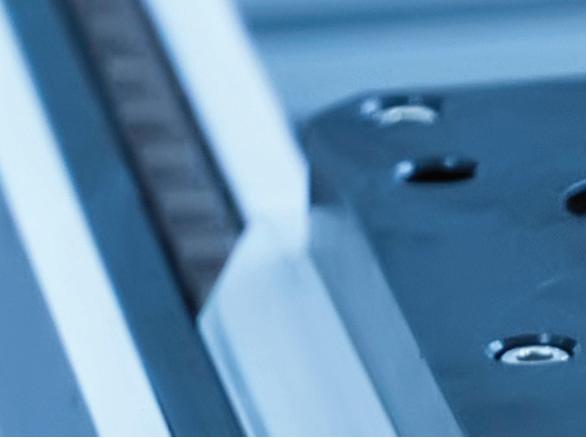

















A Supplement to Design World - AUGUST 2023 .............................................. 44 • How torque, radial and axial load impact motor selection 52 • Motion control goes small ............................................................... 56 control
Boston Dynamics’ Atlas is the most famous humanoid of all time. Atlas has been and will remain a research and development platform designed to push the limits of whole-body mobility for robotics.
Humanoids ready to take first steps
Mike Oitzman | Editor, The Robot Report
The age of humanoids is just around the corner. Humanoids are a subset of robotics that feature a bipedal (two legs) design, functional arms and “hands,” a torso and a head. It's not necessary for these robots to recreate human hands and fingers, but rather to be able to interact with a world designed for humans.
Humanoids have long been relegated to research labs, but the goalposts recently began to shi . Companies are now creating humanoids to perform various real-world tasks. This means humanoids can operate in environments designed for humans and work alongside humans.
In the short term, basic tasks for humanoids will include picking up and moving items either individually or contained within totes or boxes. Advanced functions will eventually include manipulating door knobs, opening and closing doors and drawers, and using tools designed for humans.
We will be hosting a keynote panel at RoboBusiness 2023 to discuss the state of humanoids. Jeff Cardenas, co-founder and CEO of Apptronik, Jonathan Hurst, co-founder and chief robot o cer of Agility Robotics, and Geordie Rose, co-founder and CEO of Sanctuary, will explore the technological breakthroughs that are propelling humanoids

www.therobotreport.com 44 THE ROBOT REPORT August 2023
A detailed look at the challenges and opportunities that exist for the evolving world of humanoids.
| Boston Dynamics
into the real world. They'll share their firsthand insights into the challenges and opportunities that lie ahead and discuss the industries poised to be early adopters of these remarkable creations.
Let's look at some of the humanoids that will soon be released and some of the challenges involved with developing these advanced systems.
Real humanoids won't be like the movies
While humanoids like the Terminator have long entertained us in movies, creating a functional humanoid for the real world remains a difficult task. Power consumption, power-to-weight optimization, mechanical stiffness, edge computing, component reliability and safety are some of the major engineering constraints of the humanoid design.
For decades, roboticists have worked to perfect humanoids, displaying

numerous prototypes and working models. Some researchers have spent their careers perfecting bipedal locomotion or hand design, while others have attempted to program artificial intelligence to give the robots a believable personality that crosses the uncanny valley.
One of the most famous humanoids was Honda's ASIMO, which was first introduced in 2000. Unlike most modern humanoids, with the exception of Boston Dynamics Atlas, ASIMO was a heavyweight weighing in at 130 kgs (286 lbs).
Steps in the right direction
Several technical and engineering breakthroughs have occurred since the days of ASIMO, all of which are enabling lighter-weight designs, longer operating times and faster and more capable edge computing. Advances in battery
chemistry, from the evolution of electric vehicles, provide the right balance of energy density and lower weight that are necessary to deliver longer runtimes for free-ranging humanoids.
Companies have developed edge computing platforms that can process and fuse sensor data onboard the robot while controlling all of its joints in real time. The processing power of a supercomputer can now be delivered in a small, lightweight form factor.
Artificial intelligence and machine learning have evolved so quickly in the last decade that the upcoming generation of humanoids will be able to learn quickly and respond to changes in their environment. This functionality is necessary if this class of robotics is to achieve its goal of being multi-purpose.
For this next generation of humanoids, developers have a highly capable set of technologies to leverage as they push the
45 THE ROBOT REPORT August 2023 www.therobotreport.com
The Robot Report
boundaries of what’s possible. Let’s take a look at two of the most recognizable humanoids that are currently functional.
Boston Dynamics - Atlas
Boston Dynamics Atlas is likely the most famous (real) humanoid ever produced. Atlas has been featured in a number of YouTube videos and even a Super Bowl commercial, as it performed a number of dance moves and demonstration moves on parkour courses. These videos have garnered millions of views on YouTube.
For all of its amazing abilities, Atlas remains an R&D project, and there are no plans to commercialize Altas in its current form. In fact, Atlas only operates within the confines of Boston Dynamics' headquarters in Waltham, Mass.
Atlas uses high-pressure hydraulic actuation to move its joints. That would likely have to change before Atlas is suitable for real-world work. Boston Dynamics has leveraged the R&D from Atlas to develop the commerciallyavailable Spot quadruped.
Agility Robotics - Digit
Agility Robotics is currently the only commercially-available humanoid designed for production work and being manufactured in large volumes.

The company introduced the fourthgeneration Digit earlier in 2023 and is taking orders for warehousing applications.
Digit's most unique feature is that its knees bend backward. Its legs are derived from the legs of birds and provide a highly efficient kinematic model that is responsive to unexpected inputs while being energy efficient.
Agility Robotics currently holds the land speed record for a legged robot in part because of this unique design.
Race is underway
The race is on to design and commercialize the next generation of humanoids. Several companies have raised large funding rounds to support these endeavors.
Here is a wishlist of capabilities for this first generation of humanoids:
Physical proportions of an average human: 155-175 cm (61 in - 69 in);
~70 kg (155 lbs)
Minimum 4-hour battery life
Bipedal kinematics
Two arms with functional end-ofarm tooling or hands
AI sufficient to learn from human demonstration and communicate in real-time
Hand and finger design will be a major differentiator for this first generation of humanoid robots. Recreating a mechanical hand with four fingers and an opposable thumb that is analog to the human hand remains a
difficult engineering challenge. Most of the robotics companies we highlight in the next section are designing highlyfunctional hands.
The challenge with hand design is building a hand with the desired flexibility and strength, while still being able to be manufactured at a low cost and be robust enough to survive dayto-day operations in a commercial deployment.
Agility Robotics made a key decision not to implement a high degree of freedom (DOF) hand in Digit, primarily because the robot isn't deployed into use cases where this is a requirement. Digit has a simple yet robust hand design that enables it to pick up and carry fully loaded totes and boxes within a warehouse. A higher DOF hand may be on the future roadmap for Digit once the market demands it.
The primary requirement for a functional humanoid will be to operate effectively within humanbuilt environments. These robots will be deployed into work environments already occupied by humans, and work side by side with human workers. These operating environments will include manufacturing facilities, warehouses, offices, and hospitals. The goal is not to change any of these environments to fit the robots, but rather for the robots to be adaptive to these environments.
www.therobotreport.com 46 THE ROBOT REPORT August 2023
Agility Robotics introduced the fourth generation of its Digit humanoid earlier in 2023 and is taking orders for logistics applications.
• • • • •
| Agility Robotics
Rotary Actuators with Integrated Servo Drive





The IDT Series is a family of compact actuators with an integrated servo drive with CANopen® communication. They deliver high torque with exceptional accuracy and repeatability, and feature Harmonic Drive® precision strain wave gears combined with a brushless servomotor. Some models are available with a brake and two magnetic absolute encoders with the second providing output position sensing. This revolutionary product line eliminates the need for an external drive and greatly simplifies cabling, yet delivers high-positional accuracy and torsional stiffness with a compact form factor.
• Actuator with Integrated Servo Drive utilizing CANopen®

• 24 or 48 VDC nominal supply voltage
• A single cable with only 4 conductors is needed: CANH, CANL, +VDC, 0VDC


• Zero Backlash Harmonic Drive® Gearing

• Panel Mount Connectors or Pigtail Cables Available with Radial and Axial Options













• Control Modes include: Torque, Velocity, and Position Control, CSP, CSV, CST


Simplify.
Harmonic Drive is a registered trademark of Harmonic Drive LLC. CANopen is a registered trademark of CAN in Automation. 42 Dunham Ridge, Beverly, MA 01915 | 800.921.3332 | www.HarmonicDrive.net Simplify your Design with our New, Innovative Family of Compact Rotary Actuators with Integrated Servo Drive! The Servo Drive is Inside!
INTRODUCING THE WORLD’S SMALLEST MULTI-TURN KIT ENCODERS
Miniature Package for Servomotors, Stepper Motors and Microdrives

22 mm diameter, 23 mm depth.
Full multi-turn functionality with maintenance-free rotation counterno backup batteries needed!
17-bit resolution, 32-bit rotation measurement range.
Self-calibration simplifies assembly.
SSI and BiSS C interfacesno license fees.
Find what you need with POSITAL’s online Product Finder.

1X - Neo
1X (formerly Halodi Robotics) has already successfully commercialized its first solution Eve, a wheeled, self-balancing humanoid-like robot. Neo is positioned to be a true humanoid with bipedal legged motion and functional hands.
The company raised an additional $23.5 million in Series A funding in March 2023 that included OpenAI as one of the investors. “1X is at the forefront of augmenting labor through the use of safe, advanced technologies in robotics,” said Brad Lightcap, OpenAI’s COO and manager of the OpenAI Startup Fund. “The OpenAI Startup Fund believes in the approach and impact that 1X can have on the future of work.”
Effectively, 1X is ready to graft the body of Eve to a bipedal leg base for this new generation of robots. The company has already developed autonomous navigation and facility mapping capabilities with Eve. The company has announced that Neo will be released in late 2023.
Sanctuary.AI - Phoenix
Sanctuary.AI is a Canadian company that has demonstrated five generations of its Phoenix robot. The soon-to-be-released sixth generation will be Sanctuary’s first true humanoid with legs and bipedal motion. Prior generations have evolved the torso, arms, and head of the robot. With the early versions of Phoenix, Sanctuary developed its Carbon AI software. The company has been prolific over the last year publishing a number of YouTube videos that highlight the evolving capabilities of the early generations of Phoenix.
Sanctuary.AI is targeting late 2023 for a release of the bipedal edition of Phoenix. The robot will have a height of 170 cm and weigh 70 kg
Apptronik - Apollo
Apptronik has developed and delivered several generations of humanoid exoskeletons for the U.S. Department of Defense. From this work, the company developed Astra, its firstgeneration humanoid form factor. Similar to the strategy of Sanctuary.AI, Astra was developed as a torso-only demo unit with functional arms and
hands. Apptronik developed hand-eye coordination for Astra to pick up and manipulate items.
The Austin, Texas-based company is expected to release a completely new humanoid in late summer 2023 called Apollo. There are no pictures of Apollo available yet, but I got a sneak peek of a prototype during a recent visit to Apptronik's headquarters. It has developed all of the kinematics for bipedal motion through its exoskeleton projects.
Apollo will be different from other robots on the market because its joints will be actuated by a novel actuator design. Apptronik expects this novel design feature will help reduce costs, reduce complexity, and eliminate failure points while giving joints and limbs the stiffness and actuation they require.
Figure.AI - Figure 01
With the exception of Tesla and Agility Robotics, Figure AI is one of the bestfunded companies in the humanoid race, having raised over $70 million in Series A funding. Our recent podcast conversation with co-founder and CEO Brett Adcock highlighted the progress the company is making toward the first generation of its Figure 01 humanoid.
Founded in 2022, the company has assembled an all-star engineering team with decades of humanoid experience from companies such as Boston Dynamics, Toyota Research Institute, the Institute for Human Machine Cognition, Agility Robotics, Google, and Apple.
Adcock is an experienced startup executive who has successfully launched two prior businesses. He sees humanoid development as a challenging problem, but he has a pragmatic approach to solving the big issues and has assembled all of the elements necessary to deliver a viable solution in this market. Figure AI is also teasing a late 2023 launch of its first product.
Tesla Optimus
In a famous live event, Tesla CEO Elon Musk demonstrated the first walking prototype of its Optimus humanoid. The robot tentatively made its first steps on a stage, and Musk announced this was the first time Optimus walked untethered.
www.posital.com
www.therobotreport.com 48 THE ROBOT REPORT August 2023
Advanced Products for Robotics and Automation






CGI Motion standard products are designed with customization in mind. Our team of experts will work with you on selecting the optimal base product and craft a unique solution to help di erentiate your product or application. So when you think customization, think standard CGI assemblies.


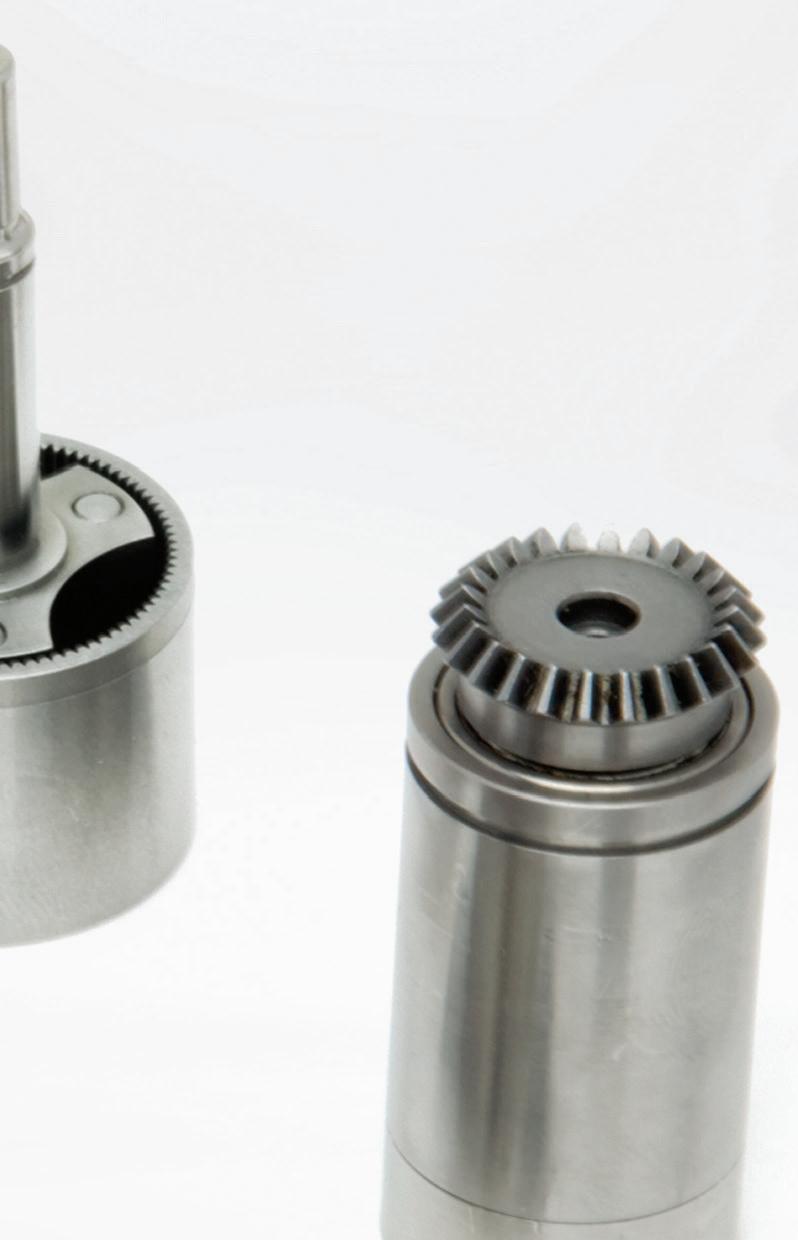


Connect with us today to explore what CGI Motion can do for you.


copyright©2021 cgi inc. all rights reserved.
YOUR CUSTOM SOLUTIONS ARE CGI STANDARD PRODUCTS
800.568.GEAR (4327) • www.cgimotion.com
With this demonstration, Tesla also threw its collective hat into the humanoid race. However, as amazing as it might have been to see Optimus walking on stage, the most amazing thing Musk announced was the $20,000 price. At a time in robotics when most (stationary) collaborative robots cost more than that, this milestone seems unrealistic.
However, one advantage for the Tesla Optimus engineering team is that they have an in-house and captive market for Optimus. The team is working with Tesla's automotive production team to define the use cases for a humanoid. Almost all of the released footage of Optimus shows it operating within a Tesla production facility. Before Optimus is ever released publicly, it will have deployed and iterated on multiple generations within Tesla.
In the months since that first demo, Tesla has continued to release additional videos of Optimus robots performing tasks. Optimus is likely one of the best-funded humanoid development projects, but Tesla has stated it may be 2027 before the product is commercially available.
Xiaomi CyberOne
Xiaomi is one of the largest smartphone manufacturers in Asia, and a public company worth well over $40 billion. The company knows how to design, build, sell, and support consumer electronics. In teasing its CyberOne humanoid, the company generated slick 3D animations of CyberOne, but only one video of real footage of CyberOne onstage with CEO Lei Jun during a launch event.
CyberOne has only been shown with a two-degree of freedom hand/wrist/ finger. This is a much simpler design than companies like Tesla, Figure, Sanctuary, and Apptronik are promising. However, this simplified but robust hand design might be more appropriate for a highend, consumer-style humanoid.
The CyberOne robot is 177 cm and weighs 52 kg, and the list price for the robot has been stated to be $100,000. The company is teasing a 2023 release date for CyberOne, but no more information has been released about the reality of this timeframe.
Fourier Intelligence
GR-1
The Figure 01 humanoid took its first steps in May 2023 –less than one year from the company’s inception.
Shanghaibased Fourier Intelligence has produced exoskeletons since 2017. The company recently unveiled its first-generation humanoid called GR-1. Standing 1.65 meters tall and weighing 55 kilograms, GR-1 has 40 degrees of freedom (actuators) all over its body. With a peak torque of 300NM generated by a joint module installed at the hip, the robot can walk at 5 km per hour and carry objects of 50 kg.

The company designed and developed the Fourier Smart Actuator (FSA) all-in-one actuator series as a high-performance, low-cost actuator. The FSA is core to the design of the company's exoskeletons and now the GR-1.
Fourier is also incorporating AI tools such as ChatGPT into the robot's interaction model to enable more natural interaction with the humans with whom the GR-1 will collaborate. Fourier Intelligence is investigating opportunities to deploy the robot for disaster relief and response, senior care, and household service.
The year ahead
The next 12 months will be an exciting period with at least five companies promising to release their firstgeneration humanoids. The key question is just how functional these new robots will be when they are initially released. But difficult challenges still abound:
Safety will be key: Another hurdle for all of these systems is safety. It's scary to think about what happens when a 70 kg (155 lb) robot fails and collapses to the ground. If one of these robots loses its footing and either tries to compensate to rebalance or falls over, it could injure nearby humans or damage property. We've all seen and laughed at the videos of Boston Dynamics Atlas being bullied by a handler with a hockey stick, but it's no joking matter when these robots are working around the general public and non-professional users.
Containing
system cost:
There is little doubt these systems will be the most complex, autonomous robots ever developed. But a significant commercialization challenge will be to minimize the bill of materials and develop robust and easily maintainable components. Component costs and the overall system price will be key differentiators for these systems.
It's expected that humanoids will eventually be collaborative, working together with humans. The safety features, recovery algorithms, and protocols developed by the various humanoid manufacturers remain important areas of research and development. It will be necessary for all of these vendors to demonstrate that their humanoids are well-behaved and have predictable failure modes before the systems are cleared for deployment.
To help with some of these development challenges, ASTM International recently created a legged robotics subcommittee. The subcommittee will focus on testing and performance standards for legged robots, including humanoids, that operate semiautonomously or in fully automated modes. RR
www.therobotreport.com 50 THE ROBOT REPORT August 2023
| Figure

torque, radial and axial load How impact motor selection
Valentin Raschke | application engineer, Portescap
Understanding the load on a motor will help pinpoint the necessary motor power and required motor accessories.
Searching and selecting a motor for a specific application can often be a challenging task, as there are many potential factors that must be taken into consideration. These include the application’s required voltage, maximum current and diameter, speed, efficiency, and power, among others. Balancing these considerations with other unique application requirements will help ensure the selection of the ideal motor, which is why a collaborative approach between the motion solution and design engineering teams from the outset is vital.
When first approaching a miniature motor supplier for assistance in the

motor selection process, one of the initial questions that must be addressed is the application’s specific working point, or the application's torque and speed. Understanding the load on the motor will help pinpoint the necessary motor power and the required motor accessories. It is also vital to discuss how the motor is integrated into the application, as different types of loads will have a significant impact on a motor’s lifetime and reliability or on the required motor design.
We will explore torque load, radial load, and axial load, which are three different types of loads that are present in common miniature motor
applications. We will also highlight why these loads are crucial to the motor selection process.
Torque Load Explained
Torque is the amount of rotational force generated by a motor during its operation. As the purpose of a motor is typically to convert electrical energy (Pelec = voltage x current) into mechanical energy (Pmech = torque x rotational velocity), torque load is present in almost any application for rotary motors.
Torque load and motor selection
In most cases, simply selecting a motor
www.therobotreport.com 52 THE ROBOT REPORT August 2023
based on the required torque value “x” won’t be sufficient. The required torque (and velocity) in an application must be understood over the entire motion cycle, as the motor needs to provide the necessary mechanical power without overheating. This means that you will often be asked by the motion supplier to provide the exact motion cycle that the motor is expected to undergo; this allows for the analysis of the maximum temperature the motor can reach before overheating.
Keep in mind that selecting the right motor requires not only under- standing the required torque value, but also the torque/speed profile over an entire motion cycle and its duty cycle.

Radial Load Explained
In certain applications, the motor or
gearbox must not only provide a certain torque to drive the load, but must also support a radial load, which is a force that is acting radially on the motor shaft. One example of this is a belt drive, which is used to drive an axis parallel to the motor. The tension force must be considered as a radial load acting on the motor shaft, especially if the belt is prestressed.
Radial load and motor selection
Radial load is relevant to motor selection due to its impact on bearing options. In the example of a brush DC or stepper motor, there are two standard bearing options: sleeve bearings or ball bearings. Sleeve bearings typically support a lower radial load than ball bearings, as well as provide a lower lifetime; this is offset by their lower cost. Depending on
53 THE ROBOT REPORT August 2023 www.therobotreport.com
Adobe Stock
Selecting the right motor requires not only understanding the required torque value, but also the torque/ speed profile over an entire motion cycle and its duty cycle
the total cost of the motor, using two sleeve bearings instead of ball bearings can decrease the cost of a motor significantly. However, for applications like the belt drive and diaphragm pump where a radial load is present, utilizing at least one ball bearing for the front bearing of the motor helps ensure a reasonable lifetime and is thus a better choice.
In contrast are brushless DC motors, which typically use two ball bearings, as they can be driven at much higher speeds compared to DC or stepper motors. A motor manufacturer will recommend a maximum radial dynamic force at which a minimum lifetime of the motor at a specific speed can be achieved. The maximum radial dynamic force will depend on the size of bearings used, the distance between the two ball bearings in the motor, and the position where the radial load applies. A long motor with oversized ball bearings typically supports a larger radial load than a shorter motor.
Axial loads in focus
There are two types of axial loads: dynamic axial load and static axial load.
Dynamic axial load explained
If an application requires a 90° rotation of the rotating movement at a lower speed, a worm gear can be an ideal solution. A worm gear consists of a worm shaft that features a spiral thread and is driven by the motor. The worm shaft drives the worm wheel with a reduction ratio as small as roughly 2:1 or larger. Following the spiral thread on the worm shaft, a radial and axial load must be supported by the motor.
Sleeve bearings are not meant for supporting significant axial loads; this means that equipping the motor with ball bearings is often mandatory. Similar to the radial load, the maximum recommended dynamic axial load of a motor will depend on the ball bearings
and preload used, the distance between the two ball bearings in the motor, and the lifetime requirement.
Dynamic axial load and motor selection
In the example of a typical axial brushless DC motor design, the dynamic axial load is supported by the front ball bearing, as the inner diameter of the bearing is bonded to the motor shaft. In case of an axial push load acting on the motor, the preload on the front ball bearing is reduced; this can lead to additional radial play, negatively impacting the lifetime, vibration, and noise of the motor. In the case of an axial pull load, the load is acting in the same direction as the internal preload, increasing its stress. Motor manufacturers will usually restrict the recommended dynamic axial load to a certain limit that can be supported by a bearing without negatively impacting its lifetime.
Keep in mind that depending on its direction, a dynamic axial load impacts the motor’s bearing assembly differently. In cases of excessive axial loads above the recommended specification, the bearing assembly or the bearings themselves must be improved.
Static axial load
Besides a dynamic axial force acting on the motor during its operation, there’s also a possibility that at least once during the motor’s lifetime, a static axial load will be applied to the shaft. This is usually the case when an additional component (for example, a pinion) is press-fitted onto the motor shaft of the assembled motor. Shock loads, such as when the motor is used in a handheld device and is dropped on the floor, are another example where static axial loads can occur.
Static axial load and motor selection
In the example of a motor equipped
with ball bearings, the recommended limit for a press-fit operation is typically much higher than for a dynamic axial load. In fact, the limiting factor is only the ball bearings’ elastic limit. As long as the static load applied to the bearing is below its elastic limit, there will be no permanent deformation of the bearing balls or raceway. However, in the same vein, exceeding the maximum recommended load could lead to permanent deformation of the bearing balls and raceway, resulting in reduced life and increased noise and vibration of the bearing.
An additional difference to consider is whether the shaft of the motor can be supported during press-fitting. Certain motors are closed or are equipped with an encoder on the back side, which prevents access to the motor shaft. Without support, the force applied during the press-fit is directly transmitted to the front ball bearing, whose inner raceway is usually bonded to the motor shaft to absorb the axial loads. Supporting the rear shaft allows for a higher force during press-fitting, as the flow of force is going through the motor shaft, not the bearings.
Conclusion
We have reviewed a selection of applications and examples where other forces, in addition to the torque load that is normally present, are acting on a motor. The most common of these are radial and axial loads, which must be taken into consideration in relation to their impact on the motor and how they subsequently influence the selection process of the motor. A dedicated motion solution provider supports customers in correctly capturing the full picture of the loads experienced by the motor in a given application and is therefore fully equipped to develop the most suitable motion solution that fulfills (even exceeds) the application/ device requirements. RR
www.therobotreport.com 54 THE ROBOT REPORT August 2023

Motion control goes small
Machine designers are increasingly asked to build systems that take up less space, operate on less power, and run with higher performance. Thankfully motion controls are answering the call with new motors, new sensors, and new architectures.
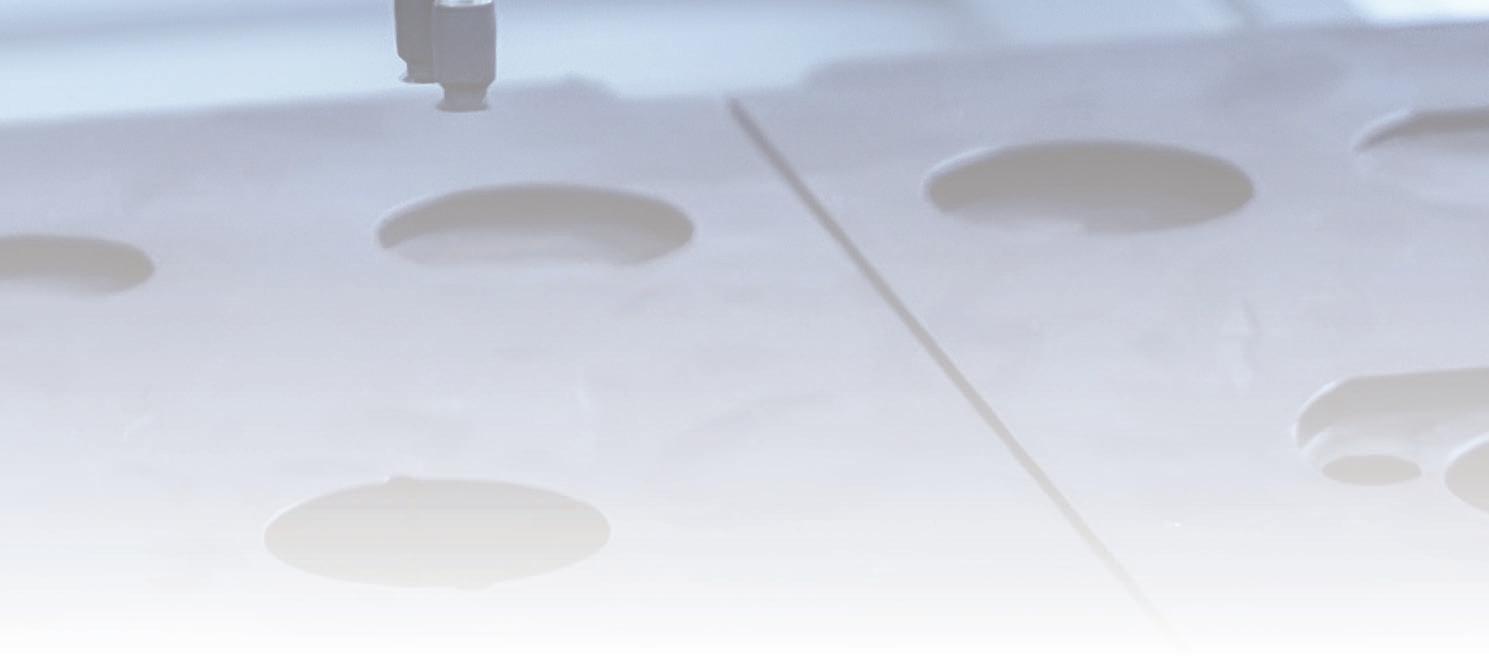



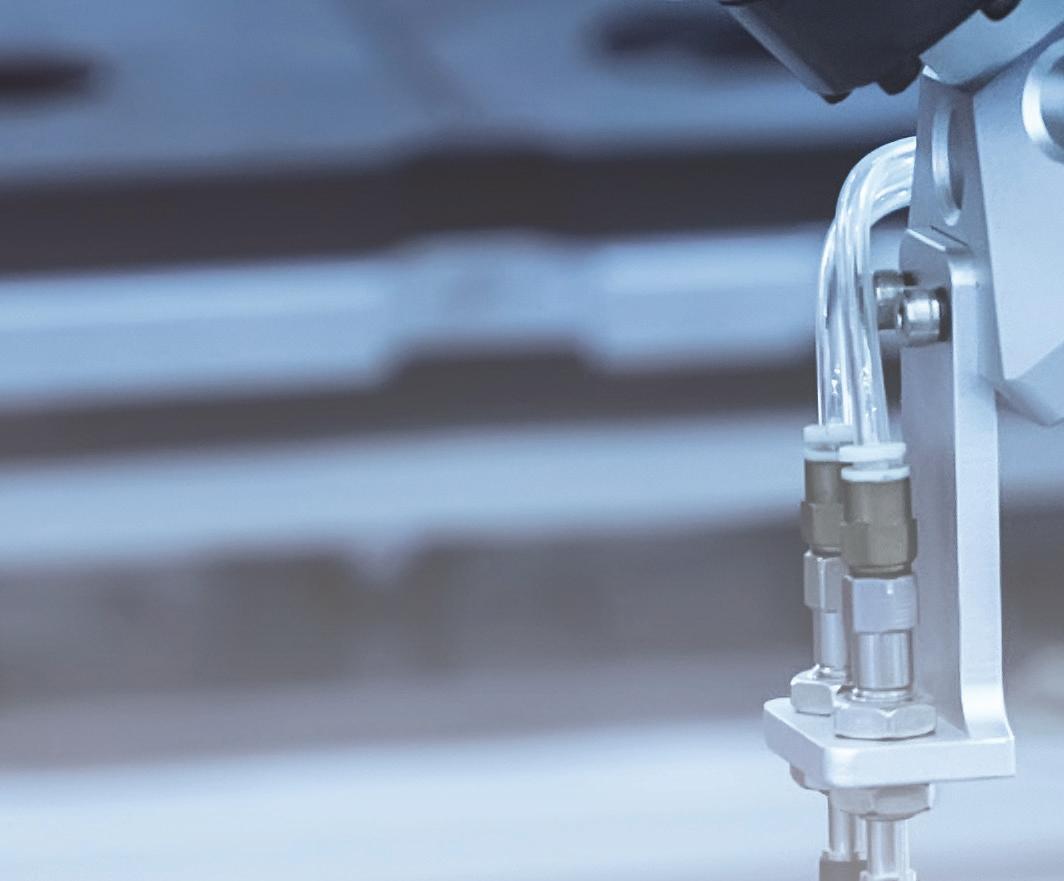




It seems that every day there are announcements of smaller and smaller motors, controls, and sensors used in precision motion control. What is driving these applications is the growing demand for motion control components used in surgical, patient treatment, mobile robotics, drones, and battery-powered applications. In this article we will introduce you to recent developments in motion control technology that are letting engineers build systems that use less power, make less noise, and take up less space.


We will look first at the motors themselves to understand how they are evolving and assimilating new sensor and control techniques to boost their performance. Then we will focus on controls to show not just how and why motion control components are physically shrinking, but how new control techniques are being used to maximize motor and system performance.
Finally we will look at how the evolution of motors and controls are impacting architecture. Because it turns out that smaller and more e cient controls allow entirely new approaches to where the controls are located, how they are wired, and how these changes are having a major impact on performance, reliability, and cost.
Mini motors 101
When comparing various motor types, power output to weight and torque output to weight are two key performance metrics to consider. For a given application, usually one of these two factors are more important than the other, and in fact, they are related because power is defined as torque times spin rate.
Brushless DC motors, with their ability to generate a constant torque up to a high spin rate, typically provide the highest figures of merit for power output to weight. Typical values are double the ratio of DC Brush motors. Step motors, although equently used in portable applications, are not usually part of the power to weight conversation because their torque drops off rapidly as rotation speed increases.

www.therobotreport.com 56 THE ROBOT REPORT August 2023
How robotics engineers can build systems that use less power, make less noise, and take up less space.
Chuck Lewin | Performance Motion Devices
|AdobeStock
If we instead want to optimize torque to weight, step motors are back on the table. Traditionally open-loop operated step motors have high holding torques, but their ability to deliver that torque over a working speed range is affected by their tendency to oscillate. Practically speaking, this means the effective torque delivered by the step motor is between 50% and 70% of the motor's rated holding torque.




There is an alternate way of operating a step motor however which largely solves this issue. A technique called closed loop servo, also called stepper servo, uses an encoder to operate the step motor as if it were a two-phase Brushless DC motor. The result is significantly higher torque over the operating range of the motor because mid-range instability, a torque killer for open loop step motors, is eliminated. More on this up and coming technique a bit later in the article.
I sense a change
An interesting aspect of the evolution of motor/actuators is how they utilize (or not utilize) sensors. As motors get smaller and smaller, and as they are implanted or strapped on to patients or used in mobile robots, it becomes harder and harder to add sensors without impacting the motor package size or the robustness of the motor/sensor combination.
So one trend affecting motors is sensorless operation - eliminating sensors and operating the motor using control techniques such as back-EMF (for Brushless DC motors) or electronic stall detection (for step motors).
There are simple and fancy ways to utilize the back-EMF of each winding of a Brushless DC motor. The most straightforward is to measure the backEMF of a floating leg while the other two legs are being driven. The floating leg, no longer influenced by the drive output of the amplifier, contains the back-EMF voltage which can be used to determine the zero-crossing point, allowing a specific location of the commutation cycle to be determined.


Back-EMF works very well under the right circumstances but has so far not been adopted in general purpose motion applications. The first challenge is that back-EMF signals disappear as the velocity of the motor decreases. So, for all practical purposes sensorless Brushless DC applications cannot be used in positioning applications where the motor needs to be controlled around a stationary location.
In a velocity control application, however, sensorless drive has seen significant adoption. Although we still have the problem of not being able to
sense back-EMF signals at low velocity, the controller can overcome this limitation by using a microstepping drive technique (operating the Brushless DC motor as a step motor) to bring it up to speed and then switching to back-EMF commutation once the measured backEMF signal provides su cient signal to noise.
When it comes to step motors, sensorless operation means more or less the opposite. Step motors can position all the way down to zero velocity but need help as the velocity increases, where they are prone to losing steps or having the motion collapse altogether. Sensorless electronic techniques can help by reducing the tendency to oscillate at certain speeds and by detecting that the rotor has stalled.
However the same "it works till it doesn't" limitation that applied for sensorless Brushless DC motors operation applies here as well. It is di cult to guarantee that electronic stall detection will work 100% reliably, so step motor applications that are really mission critical tend to use an encoder to confirm the motion.

When the going gets tough the tough get sensing
Strangely, motors of all types including
57 THE ROBOT REPORT August 2023 www.therobotreport.com
A comparison of motor types in two key performance metrics. | Performance Motion Devices
very small motors are also trending in the opposite direction, upgrading their sensors to overcome the robustness limitations mentioned earlier, or adding sensors to motor types that previously did not use them.
Upgrading the sensor for robustness o en means moving away om optical sensors, which are otherwise the workhorse of motor position sensing in the form of the quadrature incremental encoders. So to address the needs of harsh environments and medical applications there has been an uptick in the use of non-optical sensing solutions such as magnetic and capacitive encoders.
Magnetic encoders can be hermetically isolated om the motor, measuring the position through a small air gap. The motor's rotor carries a magnetic encoding disk typically mounted at the very end of the motor sha , while the electronic portion of the encoder uses either Hall sensors or magneto resistive sensing techniques to determine the rotor position. Magnetic encoders have leapt forward in resolution since their inception, and now can provide quadrature resolutions of 1,024 counts per rotation or more.
Capacitive encoders can also be hermetically sealed om the motor, and
therefore have seen growing interest for use in harsh environments and medical applications.
Aiding the adoption of these new encoder types are improvements in the controls which use high precision A/ Ds (Analog to Digital converters) and algorithmic techniques to compensate for small irregularities in the encoder's analog output signals along with fast arc-tan calculations to generate resolution-enhanced position values.
Funny, you don't act like a step motor Step motors aren't normally operated with an encoder, but are now going through an evolution which relies on an encoder to operate the motor as a servo motor- essentially spawning the birth of a fourth motor type for positioning motion applications; a er Brushless DC , DC Brush, and traditionally controlled step motors.
We will look at this technique in a bit more depth below, but the characteristics of this "new" motor type are very high acceleration rate, high torque to weight, and a reduction or elimination of the vibration issues found with normal step motors.
This new approach is driving the evolution of the step motor itself. For example, step motors used with the closed loop stepper control mode o en utilize a 3.6 deg per step design rather than the traditional 1.8 deg per step configuration, and the rotors are becoming lighter to allow higher acceleration. Typical applications for the closed loop stepper include coil winding machines, textile equipment, high speed pick and place, die bonding, and others. When the dust settles it seems that we will have two groupings of step motor designs, those designed to be traditionally controlled using full, half, or microstepping techniques without an encoder, and those designed to be controlled as a servo.
There is an interesting footnote to this that makes closed loop stepper particularly impactful for very small step
motors. With traditionally-sized step motors such as NEMA 23 or NEMA 17 it is not all that di cult to machine the rotors and 'matching' stators consistently enough to maintain a consistent step size during motion.
Step motors have a large number of 'teeth' in the rotor, each of which should align precisely with corresponding teeth in the stator for optimum equal-step motion. As the rotor gets smaller and smaller though, the relative impact of small machining inaccuracies has a larger and larger impact on the performance of the motor.
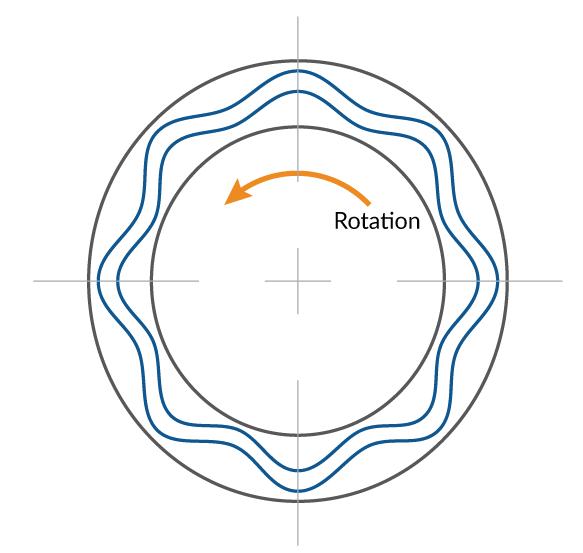
Closed loop step motor operation, because of its ability to smooth over these underlying variations, is becoming an important technique allowing step motors to keep getting smaller and smaller without need for exotic and expensive machining techniques.
Another motor type, the piezo motor, deserves an honorable mention because 'very small' has always been its bread and butter operating domain. Notably, it does not use magnetics to generate torque. Instead it takes advantage of the tiny dimensional change of piezoelectric materials when subjected to an electric field. Utilizing this principle rotary piezo actuators carefully excite the rotor disk to set up a standing wave whose phase can be changed electronically. The stator is effectively a very low-height gearhead that 'grabs' the rotor once the standing wave has been created. When the phase of this standing wave is altered, rotation occurs.
Functionally, piezo motors most resemble step motors. They excel at holding position or moving at relatively low speeds. Like a step motor they do not require an encoder to accomplish this. However, the electronics used to drive piezo motors do not resemble step motors at all, containing very specialized circuitry to generate the standing wave and control its phase.
So far Piezo motors have seen high volume adoption in specific consumer applications such as camera auto-focus
www.therobotreport.com 58 THE ROBOT REPORT August 2023
Schematic of the piezo motor | Performance Motion Devices












Manufacturing Custom Wire & Cable Solutions Since 1898 603-838-6624 • newenglandwire.com Lisbon, New Hampshire USA Since 1898, we have partnered with the most innovative companies in the world to solve complex challenges and advance technology. Our legacy of decades of expertise and unrivaled reliability makes us the industry leader in custom wire and cable solutions.
and f-stop control, and modest levels of adoption in niche applications such as ultra-high precision XYZ tables and pointing.
But given their ability to be produced in very small form factors (2 mm x 2 mm x 5 mm or even smaller), and given the larger trends in the medical/robotics world toward smaller motors, it seems a fair bet that we will be seeing more of piezo motors in the future.
Can we switch?
The single most important change driving the remarkable size reduction in electronic motion controls are the performance of digital switching amplifiers, most o en MOSFET switches. These ICs, which when first introduced were prone to failure, prone to overheating, and prone to being large, can now switch with 98%+ e ciency, are extremely reliable and have shrunk to remarkable densities.
How can a binary switch command a continuously changing output voltage? While it may seem counter intuitive, modern motion control amplifiers do not literally ampli anything. They 'ampli ' by entirely connecting, or entirely disconnecting (switching) the motor leg to an HV supply voltage or a GND connection.
PWM (Pulse Width Modulation) schemes ensure that an analog command signal can be represented in this digital all on/all off scheme. For example, to present an average of 37.3 volts to a particular motor coil with an HV voltage of 64 volts the PWM output will connect the HV 58.3% of the time (37.3 / 64 = 58.3%), and connect the ground the rest of the time.

Stay calm and switch e ciently
One fairly basic area affected by the drive electronics yet still quite important is the PWM drive equency. It may be that the PWM drive equency needs adjusting when changing om a bigger motor drive to a micro-sized motor. Ultimately the
optimal PWM equency is determined by the motor's inductance, but that generally tracks with size. Smaller motors mean lower inductance. A significant source of chatter and heat generation in small motors occurs when there is too much current ripple coming out of the switching amplifier. In the past, a PWM equency of 20 kHz may have been typical, but today PWM equencies of 40 kHz, 80 kHz, or even higher are o en needed to correctly control these motors.
How does PWM equency impact heat generation? The answer is that a digital switching amplifier delivers extraneous energy in a saw tooth pattern for a given current command. Increasing the PWM equency reduces the magnitude of this noise inducing and heat-generating current flow, and improves the accuracy of the current measurement.
Increasing the PWM equency will somewhat decrease your switching amplifier's e ciency, but this is another area that has seen tremendous IC technology progress. MOSFETs in particular have seen big reductions in what are known as 'switching losses' - essentially a fixed loss of energy per switching action. In the past switching losses could eat up 5% or more of the MOSFET's overall e ciency above 40 Khz. With the latest generation of MOSFETs this has dropped dramatically, allowing amplifiers that switch as high as 100 kHz but still operate with 90%+ e ciency.
An interesting new trend related to this is the slow rise in the use of a new switch semiconductor material, Gallium Nitride, o en called GaN for short. Traditional switchers are made om Silicon, but GaN outperforms Silicon at higher equencies when it comes to a reduction of switching losses.
While not yet common for use in motion control amplifiers, improvements in the reliability and manufacturing yields of GaN switches over the last ten years means this type of MOSFET is bound to have a growing impact on small motors and low inductance motors that need to switch at high equencies.
One thermal dagwood sandwich please Beyond improvements in MOSFET and general IC performance there has been a second, less publicized revolution happening in the area of heat flow management.
Driven by the high volume consumer LED lighting market and the challenge of managing the heat that comes om those tiny packages, a new specialized PCB, known as a metal clad printed circuit board (MCPCB) or sometimes called a thermally conductive PCB, is quickly gaining popularity for motion control amplifiers.
This technology stacks a traditional copper PCB which holds the integrated circuits such as MOSFETs, resistors, and

www.therobotreport.com 60 THE ROBOT REPORT August 2023
Metal clad PCB layers | Performance Motion Devices A switching amplifier
| Performance Motion Devices
A TAILOR-MADE INLINE SLIP CLUTCH
Engineers working at robotic companies all commonly use torque overload protection devices, slip clutches or torque limiters to prevent damage during accidental collisions between robots and other moving machines and keep actuators and speed reduction units safe. A RENCOL® Tolerance Ring can fulfill this need at a fraction of the space and weight of traditional torque limiters.
A RENCOL® Tolerance Ring, which uses spring force and friction as its operating principle, installs coaxially into a drive assembly instead of being installed in series with an assembly. It has wave features which provide a radial force that acts as the spring force to provide friction between components. The peaks of the tolerance ring’s waves embed into the ID of the mating outer housing or gear, and the ID of the tolerance ring acts as the slip surface at the interface with the inner shaft.
The RENCOL® Tolerance Ring fixes two driven components together, transferring torque during normal operation. If a torque threshold is exceeded, the tolerance ring allows the components to slip relative to each other, limiting the torque and protecting the system from damage.
All our RENCOL® Tolerance Rings are custom designed and manufactured for specific customers and can provide torque overload protection ranging from 0.15 Nm to 2100 Nm torque slip thresholds. These are the components that are currently being used in some high-performing robots that are recognized around the world.
Space and weight saving
Fits coaxially with existing components and eliminates the need for a bulky and heavy subsystem

Tailored for your specific torque requirements
Designed to slip at the specific torque slip threshold while still fitting your mating hardware dimensions and sizes
Consistent and repeatable
Provides repeatable performance over multiple torque slip cycles


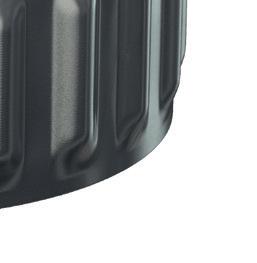

The RENCOL® Tolerance Rings guarantee immediate slip for the drive system and eliminate downtime since there is no need to reset anything after a torque slip event.


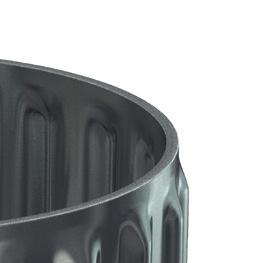

Contact us Ken Smith (401)258-7825
Kenneth.w.smith@saint-gobain.com https://www.bearings.saint-gobain.com/applications/slip-clutch
capacitors onto a relatively thick metal substrate, usually aluminum or copper. The trick to making this sandwich work is the use of a mechanically rigid dielectric layer which e ciently transfers the heat om the copper PCB to the metal layer.
Prior to the development of this heat management technology, manufacturers used a separate step to bond a traditional non heat-conducting PCB to the metal substrate. That approach is more time consuming and not as e cient at transferring heat.
A specific example of how effective such a thermal sandwich can be comes om the PMD laboratory. During one of the many thermal performance tests PMD conducts to certi its amplifier designs, our new N-Series ION Digital Drive, which has a heat sink interface area of about 10 cm2, recorded a temperature drop of only7 deg C om the bottom surface of the abovediagrammed thermal stack to the operating surface of the MOSFET. What makes this remarkable is that these measurements were taken while the amplifier was outputting nearly 2 KWs of power continuously.
Altogether this important new packaging technology has helped accelerate the power density of motion control amplifiers, allowing newer generations of motor and actuator amplifiers to achieve drive output densities of 100W per cc3 and higher.
Step motor machining inaccuracies |
Why can't I y an egg on this motor?
To finish up our discussion of advancements in motion controllers that impact small motor operation, we will look at two control techniques, one for Brushless DC motors and one for step motors that improve e ciency, and therefore reduce heat generation in the motor. For motors that may be implanted in the patient are operated by hand, cool operation is vital.
The first technique to improve e ciency we will look at is FOC (Field Oriented Control) and its close cousin sinusoidal commutation. Both of these techniques apply to Brushless DC motor control and allow these motors to operate more e ciently with more of the commanded voltage creating usable torque.
The traditional approach toward commutating Brushless DC motors is called trapezoidal or six-step commutation. This method relies on Hall sensors which provide a new commutation vector every 60 degrees, which corresponds to six discrete locations per electrical cycle.
In an ideal world, however, the commutation vector would be kept exactly 90 deg om the rotor's N-S (north south) vector at all times. The fact that instead, Hall-based controllers receive a new update only every 60 degrees, means the drive vector will be off by up to 30 degrees, and therefore ine cient. The effective torque output of the motor is reduced in

a cyclic pattern by up to 13%. Averaged over a complete rotation the average loss of e ciency is 5%.
Bring on the closed loop stepper
The second control technique we will spotlight applies to step motors. This new type of control technique is called closed loop stepper, also sometimes called stepper servo. What makes closed loop stepper powerful is that it can use a standard step motor yet extract more effective torque out of it, particularly over the full range of operating speeds. How does closed loop stepper work? Closed loop step motor operation is different in three key ways om traditional open loop step motor operation. The first is that it requires an encoder to be attached to the step motor, one with a fairly high resolution. For standard 1.8 degree step motors you will want an encoder with no less than 2,500 counts per mechanical rotation.
The second difference is that closed loop stepper operates the motor like a two-phase Brushless DC motor and commutates the phase angle using the actual encoder position. The third difference is that rather than being constant, the height and sign of the current waveform are continuously adjusted based on the output of a position PID (Proportional, Integral, Derivative) loop.
This means closed loop stepper drives the step motor with just enough power to get the job done. Open loop step systems must drive the motor at a power level to handle the worst-case profile and load scenario. The result is that closed loop stepper can drive the motor with much less heat generated.
Small step motors benefit particularly om the closed loop stepper control method. Since the encoder determines the position, small variations in the teeth spacing which would otherwise result in bumps and wiggles of the motion, are handled ‘invisibly’ by the servo, which increases or decreases the applied torque to compensate.
www.therobotreport.com 62 THE ROBOT REPORT August 2023
Performance Motion Devices

This is similar to the experience that many users have had with regular DC Brush or Brushless DC motors. A welltuned servo can do a remarkable job of masking small problems with the motor bearing, the gear head, and even the load itself. This is in fact the basis of most machine monitoring observers, and the related art and science of machine failure prediction.
By looking at how the PID’s servo error and servo error integral buildup change over time, a lot can be learned about the health of the downstream mechanical components, even if the motor is staying within its servo accuracy target spec and functioning acceptably. Machine failure prediction is a fascinating subject area which is receiving more and more attention and which we will look at in a future article.
Architecture, architecture, architecture
Let’s look at two approaches to achieving a motion controller function. In one, motors and sensors are located at the target machine while the motion controller and amplifier are located remotely, perhaps in a rack, or perhaps in the form of a motion control board mounted in an industrial computer
The second shows everything hosted locally - the motor, the sensors, and the entire motion controller. When hosted locally, the motion controller can take the form of cable connected modules, an application specific control board built from PCB-mounted modules, or an application specific control board built from an assemblage of ICs.
As it turns out, just as 'smaller is better' for an increasing number of applications when it comes to the motor and amplifier size, 'closer is better' when building machines that use motion control particularly those that integrate analog sensors such as sin/cos encoders.
The reason boils down to two simple principles: shorter signal runs mean cleaner more accurate signals, and shorter signal runs means the servo loop can run faster while still maintaining safe
phase margins. Both of these factors have a major impact on motion performance, but in particular on positioning accuracy. While some machine applications will not see big performance improvements from shorter signal runs, systems with smaller motors, and systems utilizing newer generations of encoders such as sin/cos encoders striving for ultrahigh accuracy measured in nanometers or even picometers will. Similarly, for spindles that need to maintain high position or velocity control accuracy, fast servo loops and clean sensor signals can make a big difference.
Embedded we stand
The above principle of 'closer is better' explains a slow but distinct trend toward embedded motion control solutions versus remotely mounted solutions. This trend is most noticeable for smaller machines, but can be observed even for larger machines such as those commonly used with semiconductor capital equipment, laboratory equipment, and packaging equipment.
While there may not be a big motion performance gain with embedded control in these 'bigger' applications, a single PCB-based embedded motion solution located right at the machine makes the final solution more compact relative to a machine with a control setup that uses cable bundles emerging from the machine connecting to a remote mounted control rack or industrial computer.
Cost-wise, embedded control can be cheaper than module or board based control but this is volume dependent. If the local PCB is designed at the IC level the upfront design effort is usually greater, but if there is enough volume this will be amortized over the larger number of machines and the per system cost may well be lower.
There is a new motion control device however that is easing the barrier to building application specific embedded control boards. Known variously as an intelligent amplifier, programmable
amplifier, or motion control module, these PCB-mountable devices greatly simplify the task of creating a custom control board.
This is because these devices do all the heavy lifting associated with the machine control function. They can run user application code, generate motion profiles, handle servo positioning, and drive the motor with an on-board amplifier. These devices also offer multiple interfaces, typically serial, CAN, and Ethernet. Most importantly they are small, often measuring just 3-5 cms on a side.
For the design engineer building an application specific motion control board using these plug-andplay devices, the task is more one of interconnecting then of actual circuit design. Whereas a full blown motion board designed from ICs would typically require a 10+ layer PCB and serious digital and analog design skills, a board made with these plug-and-play motion control modules is typically a 2 or at most 4 layer board, and the design task focuses on selecting connectors and specifying the board's form factor.
While not new, PCB-mounted motion control modules have shrunk dramatically in size and increased dramatically in power output over the last ten years. They are very much a product of the type of electronic advancements discussed earlier. Owing to their tremendous convenience we can safely say that these devices are here to stay and will continue to shrink in size and expand in capability in the future. RR
www.therobotreport.com 64 THE ROBOT REPORT August 2023
TOOL-LESS ADJUSTMENT COMPONENTS

• Adjustable handles and knobs replace standard hardware and can be used to torque components without tools.

• Levers can be used with Ruland shaft collars for quick installation and adjustment.

All products available directly on RULAND.COM
PRECISION COUPLINGS
• Beam couplings accommodate light weights and high misalignment.
• Zero-backlash jaw couplings for vibration dampening and a variety of performance options.





• Bellows couplings for high size to torque ratio.

Ruland Manufacturing is proud to support the FIRST Robotics Competition as a Gold Supplier of precision shaft collars & couplings.
SHAFT COLLARS
• Thousands of size and style options.
• Proprietary manufacturing processes ensure superior fit and finish.
• 8 material options.
VIBRATION ISOLATING COMPONENTS
• Rubber bumpers are ideal as end stops or mounting feet.
• Vibration isolation mounts can be sandwiched between components to dampen shock loads.
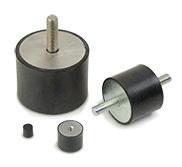
• Both types can have studs or tapped holes.
MODULAR MOUNTING SYSTEMS
• Assorted components allow you to build small assemblies for mounting sensors, conveyor rails, machine guards, and more.
• Optional pre-designed kits make it easier to select the right system for your application.
QUICK CLAMPING COLLARS
• No tools required to install, remove, and adjust.
• Best suited for systems that require frequent adjustments.

ruland.com | sales@ruland.com
WHAT’S NEW RULAND from
Robotics
Robotics
Canon U.S.A., Inc.

DC brushless Servo Motors
Today’s increasing demands of automation and robotics in various industries, engineers are challenged to design unique and innovative machines to differentiate from their competitors. Within motion control systems, flexible integration, space saving, and light weight are the key requirements to design a successful mechanism.
Canon’s new high torque density, compact and lightweight DC brushless servo motors are superior to enhance innovative design. Our custom capabilities engage optimizing your next innovative designs.


We are committed in proving technological advantages for your success.
CGI Inc.
Advanced Products for Robotics and Automation
At CGI we serve a wide array of industries including medical, robotics, aerospace, defense, semiconductor, industrial automation, motion control, and many others. Our core business is manufacturing precision motion control solutions.
CGI’s diverse customer base and wide range of applications have earned us a reputation for quality, reliability, and flexibility. One of the distinct competitive advantages we are able to provide our customers is an engineering team that is knowledgeable and easy to work with. CGI is certified to ISO9001 and ISO13485 quality management systems. In addition, we are FDA and AS9100 compliant. Our unique quality control environment is weaved into the fabric of our manufacturing facility. We work daily with customers who demand both precision and rapid turnarounds.
Canon U.S.A., Inc Motion Control Products 3300 North First Street San Jose, CA, 95134
408-468-2320
www.usa.canon.com
CGI Inc. 3400 Arrowhead Drive Carson City, NV 89706
Toll Free: 1.800.568.4327
Ph: 1.775.882.3422
Fx: 1.775.882.9599
WWW.CGIMOTION.COM
www.therobotreport.com 66 THE ROBOT REPORT August 2023
ISO QUALITY MANAGEMENT SYSTEMS: ISO 9001• ISO 13485 • AS9100 • ITAR SIX SIGMA AND LEAN PRACTICES ARE EMBRACED DAILY WITHIN THE CULTURE
SHA Rotary Actuator with Integrated Servo Drive
The SHA-IDT Series is a family of compact actuators that deliver high torque with exceptional accuracy and repeatability. These hollow shaft servo actuators feature Harmonic Drive® precision strain wave gears combined with a brushless servomotor, a brake, two magnetic absolute encoders and an integrated servo drive with CANopen® communication. This revolutionary product eliminates the need for an external drive and greatly simplifies cabling yet delivers high-positional accuracy and torsional stiffness in a compact housing.
www.Harmonicdrive.net
Robotics
Lin Engineering
https://www.harmonicdrive.net/products/rotary-actuators/integrated-actuators/sha-integrat ed-with-servo-drive

Here at Lin Engineering, we find solutions to your problems by focusing on three basic elements: Find, Optimize, and Integrate. There are such a vast number of products on the market that just narrowing the options can be difficult. Our engineers will help you find the motor you need. The motor may then be optimized for your application by changing the winding, magnets, bearings, and more. We work with your team throughout this process to configure the motor to your application so it can be seamlessly integrated within your product or assembly.


Contact info: Lin Engineering 16245 Vineyard Blvd. Morgan Hill, CA 95037
https://www.linengineering.com/ 1.408.919.0200
67 THE ROBOT REPORT August 2023 www.therobotreport.com
Robotics
42 Dunham Ridge Beverly, MA 01915 United States
42 Dunham Ridge, Beverly, MA 01915
Robotics
Robotics
New England Wire Technologies
Advancing innovation for over 100 years

Why accept a standard product for your custom application?
NEWT is committed to being the premier manufacturer of choice for customers requiring specialty wire, cable and extruded tubing to meet existing and emerging worldwide markets. Our custom products and solutions are not only engineered to the exacting specifications of our customers, but designed to perform under the harsh conditions of today’s advanced manufacturing processes. Cables we specialize in are LITZ, multi-conductor cables, hybrid configurations, coaxial, twin axial, miniature and micro-miniature coaxial cables, ultra flexible, high flex life, low/high temperature cables, braids, and a variety of proprietary cable designs. Contact us today and let us help you dream beyond today’s technology and achieve the impossible.

NEWENGLANDWIRE TECHNOLOGIES
Meet POSITAL’s New Generation of Incremental Encoders
A new generation of IXARC encoders is now available, with new sensor technology and upgraded processors for better performance and reduced energy consumption. Incremental encoders are programmable, with performance and communications interface characteristics that can be customized to meet your particular application. Multiturn absolute encoders feature upgraded self-powered rotation counters – no batteries required! With a wide range of mounting and connectivity options available, IXARC encoders can easily replace encoders from most major manufacturers.
More NeXtGen products are on the way, including kit encoders for direct integration with motors and drives. Stay tuned for new announcements!

www.therobotreport.com 68 THE ROBOT REPORT August 2023
Contact info: New England Wire Technologies www.newenglandwire.com 603.838.6624
FRABA Inc. 1 N. Johnston Ave., Suite C238 Hamilton, NJ 08609 USA 609-750-8705 www.posital.com
Ruland Manufacturing
Zero-Backlash Couplings for Robotic Systems
Ruland Manufacturing offers a variety of zero-backlash servo couplings designed for use in high precision applications like automation and robotics. Ruland offers beam, bellows, disc, oldham, jaw, and newly-released Controlflex couplings in thousands of off-the-shelf combinations and sizes to help designers optimize their systems.

Robotic vision systems, material handling robots, and automated guided vehicles have infamously strict requirements that require engineers to balance torque, weight, dampening, and more, all while retaining extremely precise power transmission. Ruland servo couplings excel in demanding applications and can be selected based on a wide variety of performance characteristics.
Visit Ruland.com for access to everything you need to make a coupling design decision including: full technical product data, 3D CAD models, installation videos, and eCommerce to make prototyping easy.
THK Micro Cross-Roller Ring Series RAU
The THK micro-size Cross-Roller Ring RAU features a 10mm inner diameter and a 21mm outer diameter. It is more compact, lightweight and rigid than a double row angular contact ball bearing type. RAU rollers travel on V-shaped raceways ground into the inner and outer rings. Alternating rollers are arrayed orthogonally so that one bearing can support loads and moments in any direction. Spacer retainers enable smooth movement and high rotation accuracy.

Ruland Manufacturing
6 Hayes Memorial Dr. Marlborough, MA 01752
508-485-1000
www.ruland.com
email: sales@ruland.com
https://www.thkstore.com/products/rotation/cross-roller-rings/rau.html
Phone: 847-310-1111
www.THK.com
69 THE ROBOT REPORT August 2023 www.therobotreport.com Robotics
Robotics
THK America, Inc. 200 East Commerce Drive Schaumburg, IL 60173






















Sponsorship opportunities are available for future DeviceTalks and Robotics programs. For more information, contact Colleen Sepich. 857.260.1360 | csepich@wtwhmedia.com Medtech conversations that inspire the next generation of devices OCTOBER 18-19, 2023 SANTA
CENTER
CLARA CONVENTION

AUTOMATION Covering the latest motion and control components, equipment and systems in ASRS design www.designworldonline.com A Supplement to Design World - August 2023
WAREHOUSE
Rohlik installed Brightpick Autopickers in a Prague fulfillment center without changing its process significantly. The robots almost eliminated picking labor and dramatically reduced costs.

Grocery fulfillment giant picks a bright future
By Rachael Pasini • Senior Editor
72 August 2023 www.designworldonline.com DESIGN WORLD
| Courtesy of Brightpick
A er a successful pilot in Prague, Brightpick’s AI-powered warehouse robots will automate order picking, consolidation, and dispatch for Rohlik Group, one of Europe’s largest e-grocers.
WAREHOUSE AUTOMATION
The human hand is said to have 27 degrees of freedom — and as any robot designer will tell you, that’s not an easy thing to replicate cost-e ectively.
“Replacing the human hand is extremely di cult,” said Jan Zizka, CEO of Brightpick. “I think some companies tried, and it ended up costing €50,000. You would need to sell billions of those hands to get to a reasonable price.”
Human evolution has granted us attributes that enable survival and advance our capabilities, such as picking and holding objects of irregular shapes and various textures. Though robots and automation technology have yet to catch up, e-grocery warehouses can usually get away with simpler motion — with vacuum grippers, for example — but not without challenges.
“In e-grocery, there’s a well-defined portfolio of items, but they’re still quite diverse. There are bags and boxes of di erent thicknesses. Some materials are porous and don’t work well or at all with a suction cap,” said Zizka. “Throughout our company’s history, we’ve probably designed around 200 grippers, not only for grocery, but also for very specific items in automotive, and some for as general of use as possible.”
Brightpick recently completed a nine-month pilot of its robotic solution in a Prague fulfillment center for Rohlik Group, one of Europe’s largest e-grocers with more than 1.5 million customers and 12 million orders per year. The solution includes autonomous mobile robots (AMRs) that fully automate order picking, consolidation, and dispatch. Rohlik plans to roll out the Brightpick solution across multiple warehouses in 2023 and 2024, starting with Munich in July 2023

T
DESIGN WORLD www.designworldonline.com August 2023 73
and continuing with Frankfurt, Vienna, Prague, and other fulfillment centers. Once fully deployed in the Munich warehouse, the center will be able to dispatch more than 1,000 order totes per hour and 5,000 completed orders per day, where some orders contain multiple totes.
“Brightpick Autopicker is our flagship product with a relatively simple arm, which makes it a cost-effective solution,” said Andrey Bakholdin, VP of marketing and business development at Brightpick. “Even though the arm only has two degrees of freedom, the gripper, or the suction cap, that we designed can grab items at a 60° angle. With our AI and 3D-vision cameras, we can pick most ambient groceries and now chilled groceries.”
Item picking is a major operational challenge, as grocery orders contain an average of 30 items per order. A typical grocery fulfillment center also has various picking zones for ambient, fresh, chilled, and frozen items. Brightpick’s mobile robot solution automates both picking and order consolidation across these different zones. The robots are patented
WAREHOUSE AUTOMATION
and powered by proprietary machine vision, AI algorithms trained on more than 250 million picks, and machine learning to improve with each pick.
“We use 3D vision and artificial intelligence to learn how to create better grippers. Our machine learning has seen enough items to generalize unseen items and make the robots smart enough that they don’t need to be retrained. This is the magic and probably the biggest milestone we’ve had thus far,” said Zizka.
Brightpick Autopicker robots are like humans with carts that move around the warehouse, retrieve product storage totes from shelving, and robotically pick items from those totes to consolidate orders directly in the aisles. The robots don’t need to travel back and forth to centralized picking stations. This results in faster picking, and they reliably pick most groceries with 99.9% accuracy. They also include goods-to-person capabilities for items that require human dexterity and autonomously find the nearest human picking station.
In most online grocery fulfillment centers, including Rohlik’s, picked items
are sent via totes on conveyor belts to a central location for consolidation.
Brightpick Dispatcher robots consolidate items arriving from various picking zones into completed orders to dispatch for delivery, curbside pickup, or in-store pickup. These robots can also pre-pick orders and store them in a temporary staging area until they need to be dispatched. This enables warehouses to smooth out picking volumes throughout the day and increase total daily throughput.
Brightpick Intuition software is the AI-powered brain of the solution that guides the robots from picking all the way to dispatch. A typical warehouse will have 15 to 100 robots, which companies can remotely monitor and control, tracking every robot, order, tote, and item in real time.
The fully autonomous, end-toend robotic solution reduces picking labor by 95% and cuts costs for order fulfillment by half. However, humans are still needed in any warehouse regardless of how many robots there are and how much programmable intelligence they have.
“The human element is a huge differentiator for us because we provide an end-to-end solution,” said Bakholdin. “We don’t just do robotic picking — we also do storage, retrieval, consolidation, and so forth. And because we can always go to a human, as a last resort, we always get the order picked. There’s no single point of failure.”

74 August 2023 www.designworldonline.com DESIGN WORLD
| AdobeStock.com
The robotic arm and vacuum gripper picks and consolidates items in the aisles to reduce travel time and increase picking speed.
| Courtesy of Brightpick
POWERING... AUTOMATED WAREHOUSES







Automated warehouses use many facets of automation, such as autonomous storage and retrieval systems, moving conveyor systems, palletizing and sorting systems, and automated guided vehicles and robots. Found throughout industries such as automotive, machine building, food and beverage, material handling, logistics, and e-commerce, warehouse automation is a fixture in today’s industrial environment. HELUKABEL offers a wide array of flexible and continuous-flex control, data, VFD/servo power and feedback cables, as well as the guidance and protection systems to ensure the transmission of power and data remains constant so materials stay on the move and arrive at the right place in your facility just in time.

Oftentimes, when providers install robotic pickers as a point solution and can’t pick certain items, humans must physically go to the robots to fix them, move the items, or restart the system. In this case, picking issues aren’t handled as part of the process flow and are considered failures.
Contrarily, with so much talk about collaborative robots and humans working efficiently with machines, Brightpick actualizes this concept by designing a robot’s inabilities into the workflow. Humans are included in fallback scenarios that keep operations running, so much so that there don’t appear to be any issues on the floor. And the machine-learning algorithms can collect information to make the robots smarter for next time.
The icing on the cake — and what e-grocers such as Rohlik love to hear — is that the solution takes mere weeks to deploy.
“There are three reasons we can deploy so quickly,” said Bakholdin. “First, we use standard commodity shelving and totes that can be procured anywhere, so they are very easy to assemble. Second, our robots use LiDAR for navigation, which is purely visual, so you don’t need any magnetic tape, QR codes, or fencing around the system. And the third part is probably the most important: All the heavy lifting — designing the solution, simulating it, and ensuring that it works — happens before the installation begins.”
The company uses a warehouse’s
real-life historical data to create a detailed simulation and test the solution extensively to visualize the system’s behavior before installation. The team designs a digital twin of the facility and robot fleet and delivers an animation of the process and a detailed report with metrics. This simulation saves upfront time and costs to ensure the solution meets physical requirements and performance expectations.
“All the robots are standalone, selfsufficient, and equal,” said Zizka. “The entire idea is that there’s no single point of failure. If someone turned off or removed all the robots in the warehouse for some reason, the system would still work. Performance would be lower, but it would work exactly as before. We’d bring the robots, connect them to the Wi-Fi, and they’d run. It’s like plugging a USB stick into a laptop.”
Brightpick Autopickers were designed for e-commerce and grocery retailers and are suitable for large, small, and micro-fulfillment centers. They work with standard warehouse shelving and totes, enabling fast deployment and easy integration with any warehouse environment, including existing operations and mezzanines. l WH
Brightpick brightpick.ai

WHAT DO YOU THINK?
AUTOMATION 76 August 2023 www.designworldonline.com DESIGN WORLD
Brightpick Intuition is the AI brain that orchestrates and optimizes the robot fleet.
Connect and discuss this and other engineering design issues with thousands of professionals online
| Courtesy of Brightpick
Brightpick Autopickers were designed for e-commerce and grocery retailers and are suitable for large, small, and micro-fulfillment centers.
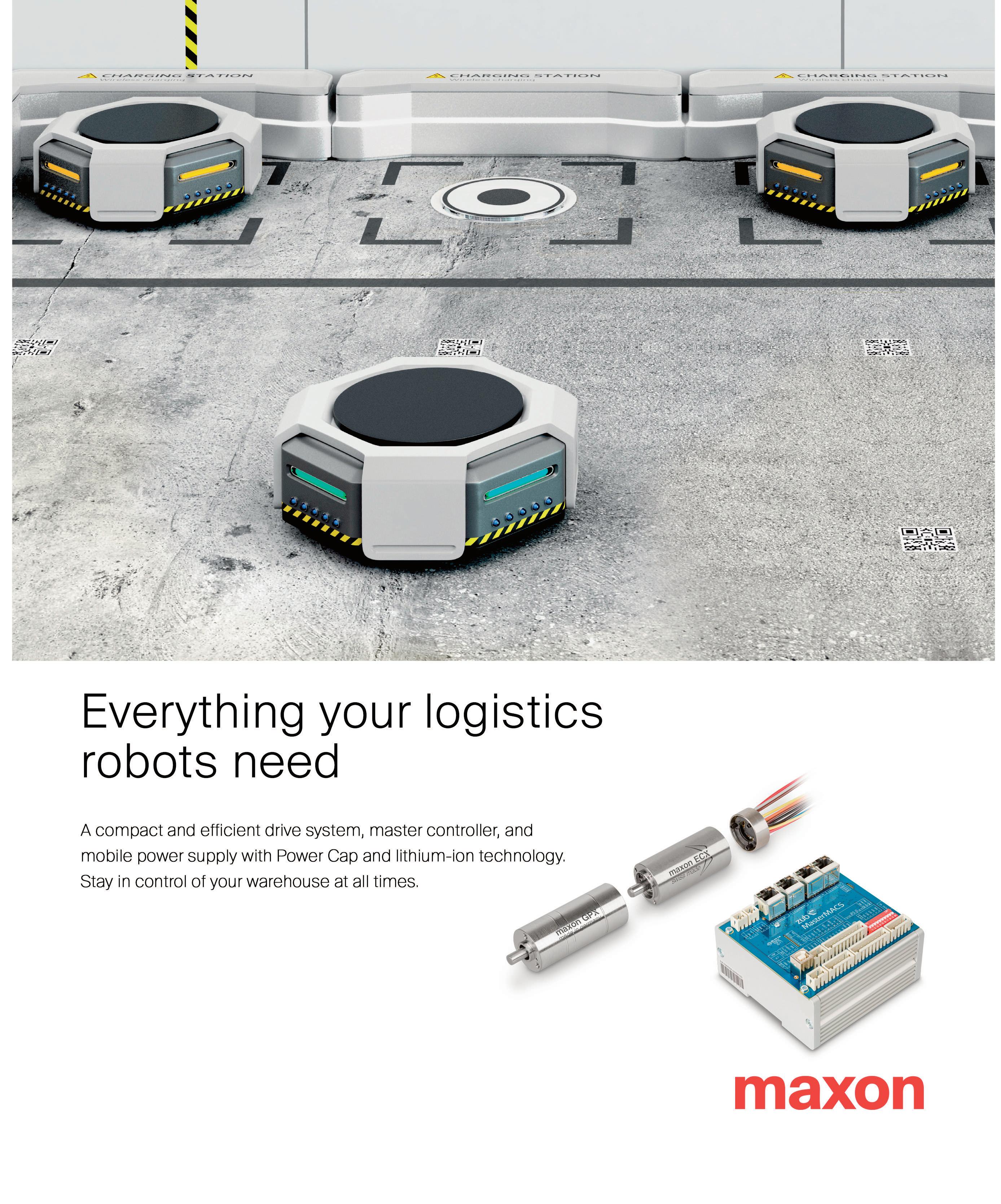
Warehouse workers use headsets and wearables with voice-directed AI technology that synchronizes humans and machines.
By Rachael Pasini • Senior Editor
AI-embedded tech helps secure the warehouse workforce

The sudden pandemic-related labor shortage was an eye-opener that forced companies to rethink operations and plan for more changes. As employee populations shi toward “digital natives,” companies can leverage such workers’ tech skills to increase e ciency and throughput.
Before Siri or Alexa, there was Jennifer — a voicedirected technology that links humans and machines to orchestrate warehouse operations. She’s an AI workhorse that provides comfort and confidence in people-occupied facilities.
“Jennifer can manage several hundred workers simultaneously, constantly recalculating orders and line items,” said Ken Ramoutar, CMO at Lucas Systems. “She does all kinds of smart things that workers don’t see, but they feel the results. For example, a warehouse worker might walk six or eight miles daily. Jennifer helps them get the job done in half that distance.”
78 August 2023 www.designworldonline.com DESIGN WORLD
| Courtesy of Zebra
WAREHOUSE AUTOMATION
These days, automation technology such as AGVs and AMRs get the spotlight for solving labor issues, reducing costs, increasing throughput, and making operations more efficient. But there’s still a sizable number of warehouses depending solely on people.
“We’ve been around 25 years, and more than ever, warehouse workers have become recognized as a huge asset,” said Ramoutar.
COVID-19 taught the world the value of distribution center labor. To prepare the industry for another wave of change — with Generation Z entering the workforce — warehouses need to consider the role of technology in employee retention.

“It’s hard work. It’s stressful work. So, if you want to attract the younger workforce, you better have good tech that helps them, trains them, and gives them information — all things that group expects,” said Ramoutar.
Gen Z grew up with smartphones, tablets, and voice-directed watches. Digital interfaces are as intuitive to them as operating a kitchen faucet. They have quick learning curves for modern gadgets and devices that occupy their daily lives and expect workplaces to supply them with what they need to do their jobs.
But it’s not just Gen Zs. Across the board, employees expect operations to include technologies that make their jobs better and safer.
According to market study insights from Lucas Systems, people value technology so much that they are willing to take a pay cut and switch jobs to use tech that helps them work.
The study polled 500 U.S. onfloor warehouse workers in May 2022 to examine their relationships with technology and their fears, expectations,
and perceptions about their daily jobs. Developed as the “Voice of the Warehouse Worker,” the study was conducted by Wakefield Research for Lucas Systems. In the study, nearly 3 out of 4 (74%) on-floor workers said they would consider a pay cut at another company for an opportunity to use technology if it helps them in their job. Workers also said they are physically spent, spending over a third of their day walking, and would welcome tech’s help in the form of robots or other tech tools.
Other market study insights included:
• 75% of workers said physical strain in their jobs takes a larger toll on them than mental strain. The leading cause of physical strain is carrying or lifting, followed by walking or traveling.
• Top causes of mental strain include meeting performance or incentive goals and objectives (25%) and safely maneuvering around the warehouse (20%).
• Workers see robots as productive allies
but fear increased quotas. More than two in five believe robots will reduce physical stress (46%) or help them achieve better speed in item picking (44%) or better accuracy (40%).
• In the study, workers perceived their company’s technology as an investment in them. Lucas Systems says this is meaningful in an industry already facing a labor shortage.
“We’re in 400 warehouses across the globe, and there aren’t too many robots in any of them. Many people are thinking about robots and might install a couple to see where they make sense. Then, they might add a few more. We believe this ecosystem of people and robots will be the end game,” said Ramoutar.
Warehouse leaders agree that helping humans and machines get along is critical for automation success. They also understand that AI-embedded technology is the link for efficient
DESIGN WORLD www.designworldonline.com August 2023 79
human-machine interactions, but many feel unsure of how to make AI work in their facilities.
According to another Lucas study released in 2021, executives are optimistic about AI — counting on quick and generous returns from their investment and expecting an average ROI of more than 60% within five years of implementation. Despite this optimism, 99% of organizations face challenges using AI e ectively.
The top reasons are:
• Perceptions of high costs compared to benefits
• Concerns about risks and control of operations decisions
• Cost and time for training and a lack of understanding of implementation
Nearly 90% of respondents, regardless of industry, admitted they need more expertise and information regarding implementation and use.
“There’s a belief that AI is a heavy lift — that it’s di cult to use and risky or expensive. This thinking prevents widespread adoption in the warehouse and the ability to tap AI’s true potential,” said Ramoutar.
Lucas believes the key to driving transformational impact in the warehouse is providing AI where users or IT sta don’t
WAREHOUSE AUTOMATION
have to be experts to leverage AIembedded technologies, such as voice, dynamic slotting, and in-warehouse travel optimization solutions.

For example, earlier this year, the company announced its rollout of new technologies promising productivity, comfort, and ease of use for the future Gen Z workforce.
The technologies — built to serve the new “iGeneration” of workers born between 1997 and 2012 — promise to reduce worker stress, provide a less physically-taxing work experience, and help on-floor supervisors be more agile. New technologies include:
• An all-new supervisor management console that provides leadership with a high degree of flexibility and agility to customize data, dashboards, and analytics specific to their operation and needs. Supervisors and managers can get actionable information in a way that’s easy to understand and use through fully customizable consoles.
• New algorithms and machine learning intelligence that reduce walking by up to 50% by showing workers optimal navigation paths.
• The ability for on-floor workers to use the smallest wearables for scanning. Lucas Systems certified its voice-enabled
optimization suite, Jennifer, to run on a Zebra WS50, the world’s smallest all-inone Android enterprise-class wearable mobile computer.
These insights were released in the company’s “Competing for the Warehouse Workforce of the Future” guide, which includes recommendations for attracting and retaining labor. One insight is that most Gen Z workers (73%) say robots will help them achieve greater accuracy and speed in their jobs.
“It’s a competition, and it’s not going to get better,” said Ramoutar. “Baby Boomers and Gen X don’t necessarily expect a super automated place. It’s the Gen Zs who are asking, ‘Where’s the good tech that I need to do my job?’ So, if a warehouse looks outdated and hasn’t been modernized, they won’t work there.”
It’s clear that no matter how many robots are deployed worldwide, warehouses will still need people for quite some time. That means the industry will continue needing AI-embedded tech to synchronize operations for future hybrid — and diverse — workforces.

For instance, Jennifer understands and speaks 34 languages, removing communication barriers that make expansion, hiring, and training easier and faster. Workers can also adjust Jennifer so that she speaks slower or louder, accommodating a broader range of people.
“We have places in the U.S. where Jennifer works in multiple languages in the same warehouse. Individuals speaking Spanish work alongside others speaking Arabic. And the supervisors are probably speaking another language or English. They all can work better and faster with less stress without a common language,” said Ramoutar. “Having this tech for people matters.” ● WH
80 August 2023 www.designworldonline.com DESIGN WORLD
Lucas Systems | lucasware.com
Jennifer has a natural human voice that workers can adjust, enabling diversity and inclusion in the warehouse.
| Courtesy of Lucas Systems
Supercharge your production efficiency, simplicity, and connectivity with our extensive portfolio of linear and rotary mechanical systems, servo drives and motors, control solutions, and I/O systems.

Automate everything that moves on a single, unified platform Install and commission all elements of the automation chain more quickly Integrate solutions into your automation concepts with minimal risk

Explore what’s possible with Electric Automation Solutions by Festo.





Talk to us today.







www.festo.com/ea
By Rachael Pasini • Senior Editor
Small and speedy wins the race
Modern intralogistics technologies place high demands on drive systems. In many instances, drives must release tremendous force in confined spaces and perform precise positioning tasks in continuous or stop-and-go operations. Speed is also essential, as many thousands of orders must be processed daily.

To speed up warehouses, automatic storage and retrieval machines, driverless transport systems, and intelligent logistics robots are taking over an increasing number of work steps in storing, retrieving, and preparing items for dispatch. Flexible systems that work reliably around the clock keep operations moving cost-e ectively and are often driven by high-performance micromotors. Small motors are crucial for controlling robot movements, enabling them to navigate environments, manipulate objects, and perform various tasks. Examples of how motors are used in warehouse robots include:
• Wheel propulsion: Mobile robots employ motors to drive their wheels or tracks. By controlling the speed and direction of the wheel motors, the robot can move forward, backward, turn, or navigate in di erent directions.
• Steering: Motors are used for steering mechanisms in robots with multidirectional capabilities. By controlling the rotation of the steering motors, the robot can change its direction of motion or perform complex maneuvers.
• Actuation: Motors can act as actuators to perform various tasks. For example, they can be used in robotic arms for grasping, lifting, or manipulating objects. They can also extend or retract appendages, open and close doors, or operate other mechanical components.

82 August 2023 www.designworldonline.com DESIGN WORLD
Fast-paced warehouse operations demand extensive automation, which is inconceivable without micromotors.
Faulhaber weighs in on intralogistics robots and how drive system capabilities influence their design.
Mobile robots require compact, lightweight, high-torque drive systems to improve warehouse autonomy and accuracy.
| Courtesy of FAULHABER
• Sensors and feedback control: Encoders or other position sensors can be attached to the motors to provide feedback on their speed, position, or torque. The control system uses this feedback to adjust and regulate the motor’s behavior, ensuring accurate and precise movement.
• Balance and stabilization: By controlling the torque and movement of the motors, robots can maintain balance and stability while navigating uneven terrain.
• Obstacle avoidance: Motors can be combined with sensors to prevent collisions. The sensors detect obstacles or proximity to objects, and the motors are controlled to steer the robot away from potential hazards.
“Intralogistics robots work in dynamic environments where they must recognize and avoid obstacles and ensure safe

WAREHOUSE AUTOMATION
to “Intralogistics 4.0.” They are used for storage, removal, and dispatch preparation to optimize material flow, relieve employees, and replace conventional lift or pallet trucks.
For example, autonomous picking robots allow precise handling of individual objects. A typical picking robot comprises a lifting column, gripper, and a drive unit — perhaps a Faulhaber BX4 series brushless dc servomotor with an integrated motion controller and planetary gearhead. When used in the gripper, this combination ensures precise positioning during storage or retrieval, all during continuous operation with constant load changes. Yet the complete drive unit weighs only about 300 g and doesn’t require a counterweight even when the gripper fully extends.
cooperation with other robots and human workers. They need to be flexible and adapt to changing processes and the goods they handle,” said Kevin Moser, business development manager at Faulhaber.
Faulhaber engineers address challenges that modern warehouses face by evolving drive systems to match the industry’s shrinking need — the need for smaller, more powerful motion control components that reduce weight and improve speed.
Motion control for the modern robot Autonomously driving and selfcontained logistics robots
The brushless dc servomotors are compact, with a diameter of only 32 mm and a length of 85.4 mm. This small size makes it possible to design a very flat gripper that can pick up packages stored just above the ground, making optimal use of expensive storage areas. With the brushless commutation system, the motors are long-lasting, deliver high torques, and run quietly with a balanced rotor. Integrated current control limits torque demands and protects the drive against overload.
“Robot design needs to be robust, lightweight, and very compact, resulting in low maintenance, low power consumption but high efficiency for

DESIGN WORLD www.designworldonline.com August 2023 83
are critical
The BX4 series of brushless dc servomotors are designed for high-precision, start-stop operations in confined spaces.
| Courtesy of FAULHABER
extended battery life and minimum downtime,” said Moser. “Modularity is also important: As operations expand in a modular system, it is easy to add additional robots.”
Graphite-commutated dc micromotors of the CXR series combined with matched gearheads have also proven themselves in handling tasks. Their commutation system is well suited for dynamic, high-performance applications with fast start-stop operations required in many handling systems and automatic sorting, such as where switches are used to change routes on transport paths.
With their linear characteristics, the dc motors are easy to control. Combined with high-resolution encoders, they are ideal for precise positioning tasks. High-quality neodymium magnets and Faulhaber winding ensure high-power density in a compact design. The motors can be installed directly in handling elements and lift considerable weight despite their small size.
“As the degree of automation of intralogistics processes throughout the entire value chain increases, robots must be more autonomous, intelligent, and interconnected. Requirements regarding the speed and dynamics of the systems are increasing as well. This requires the robots to have reliable, safe, and smart
WAREHOUSE AUTOMATION
sensor and drive system technology to adapt to these changing conditions,” said Moser.
Warehouses often choose automated guided vehicles (AGVs) for flexible transport within a facility. Availability, speed, flexibility, and small size are essential requirements for these transport systems’ drives. Current consumption also plays a role in ensuring that AGV batteries are as long-lasting as possible. For example, brushless dc servomotors of Faulhaber’s BP4 series drive the wheels, whereby the motor power transfers to the wheels via planetary gearheads and drive belts. High-efficiency motors with innovative winding technology allow for a high copper content that minimizes losses.
Encoders of the IE3-1024 series are built right onto the servomotors for precise position detection. The magnetic incremental encoders feature an indexing channel for referencing a drive shaft revolution and a standardized, electronic encoder interface. The resolution, direction of rotation, index width, and index position can be adapted to the application, and a motion controller controls the servomotors. Such drive systems are also used for mobile robot platforms, which move autonomously in facilities without preinstalled guidance systems.

Micro-fulfillment seeks even smaller tech

Warehouse robots continuously become more autonomous in navigating complex environments, adapting to dynamic surroundings, and making
The BXT series are brushless flat motors for compact wheel drives that move mobile robots around the warehouse.
| Courtesy of FAULHABER
real-time decisions. Improved motion control and sensing systems, advanced algorithms, and artificial intelligence enhance their independence, increasing efficiency and productivity. And as the trend of micro-fulfillment increases, so will demand for even more compact but powerful drive systems.
For example, high-torque flat motors of the BXT series are useful for wheel drives when installation space is limited in the axial direction. These motors are 14, 16, and 21 mm long but deliver torques up to 134 mN-m within diameters of 22, 32, and 42 mm, respectively. For precise speed control or strict positioning accuracy requirements, diameter-compliant magnetic encoders or speed controllers are fully integrated into the housed motor variants, expanding the drive by a mere 6.2 mm.
“High efficiency, high power density, and overload capability will be key,” said Moser. “The more compact the drive system, the more space is left for the battery system, and the highest power-to-weight ratio enables increased payload weight per shuttle.” l WH
storage and retrieval.
| Courtesy of FAULHABER
Faulhaber
faulhaber.com/logistics-robot/en
84 August 2023 www.designworldonline.com DESIGN WORLD
A brushless dc servomotor with an integrated motion controller and planetary gearhead drives this gripper for precise positioning during
MULTI CONNECTION SYSTEM
ELIMINATE VARIABILITY RELIABLE FIELD CONNECTIONS WITH NO TOOLS!

WAGO has the interconnect solution for your factory automation devices. With lever-operated termination, the 2734 Series MCS MINI offers a toolfree, easy in-hand wiring of wire-to-board and wire-to-wire configurations. With a pin spacing of 3.5mm and termination of wire up to 14AWG, these are the optimal field connectors for drives and motion controllers. www.wago.com/us/discover-pluggable-connectors/mcs

Festo Electric Automation for Intralogistics Drives Competitiveness






By standardizing on Festo electric and pneumatic automation solutions, original equipment manufacturers (OEMs) not only gain design symmetry and a sleek, high-tech look for their Intralogistics systems, they can also manufacture more compact, flexible, and high-performance solutions. Through partnership with Festo, OEMs simplify their design and acquisition process for faster time to market.

Electrics with the simplicity of pneumatics

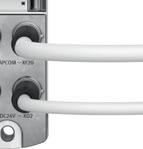
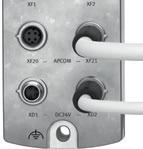
The Simplified Motion Series (SMS) electric axes feature a motor with integrated servo drive and IO-Link that, for the first time, makes electric axes comparable to pneumatics in terms of cost and installation ease. SMS machine-mounted electric axes offer low energy consumption and the data generation characteristics of mechatronic systems. No other supplier offers a line of electric axes with comparable capabilities, advantages, and price of the SMS.
SMS actuators are ideal for picking and placing, dropping, pushing, lifting, or trapping products on a conveyor line. The series has a simplified form factor and dynamics. SMS adds flexibility to the system while minimizing energy costs and costs per I/O point by utilizing IO-Link communications rather than analog signals.





Axes are available in ball screw, toothed belt, mini slide, electric cylinder, piston rod, and rotary actuator configurations. With onboard push button commissioning, users commission two-position actuation in minutes with no additional software required. Like pneumatics, the system uses two inputs and two outputs to perform controlled pressing, force functionality, and end-to-end positioning.
SMS is designed with economies of scale in mind. SMS decreases costs by high volume standardized production. This eases supply chains issues and means customers receive electromechanical actuators in a variety of form factors quickly and at an industry leading price point.
IO-Link programming through the PLC unlocks infinite
positioning and enables diagnostics, including cycle count, alarm data, and the typical process data experienced with servo systems. IO-Link also delivers operational data for improved quality and predictive analytics ‒ another key differentiator compared to pneumatic actuators. PLC speed control is based on application dependent requirements.
Next generation remote and decentralized I/O
CPX-AP-A is Festo’s next generation modular, lightweight, and flexible remote I/O system with IP65/IP67 protection. CPXAP-A supports flexible placement of Festo’s SMS products. CPX-AP-A remote I/O has a real-time transmission rate of 200 Mbps full duplex. It is parameterizable and scalable to up to 15 modules in one automation system. CPX-AP-A features a complete IO-Link master data storage mechanism, including a device parameterization tool. CPX-AP-A can be adapted to Festo valve terminals.

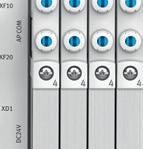







In addition, CPX-AP-I decentralized I/O with IP65/ IP67 protection seamlessly integrates with Ethernet


86 August 2023 www.designworldonline.com DESIGN WORLD ADVERTORIAL
communications networks from Rockwell, Beckhoff, Siemens, and other leading PLC manufacturers. CPX-AP-I modules accommodate over 80 digital and analog input blocks, valve manifolds, and IO-Link master modules for extensive control and data acquisition capabilities per interface. CPX-AP-I supports up to 50-meter distance between SMS devices, IO modules, valve terminals, and CPX-AP-A nodes. With 50-meter capabilities, locating valve manifolds close to pneumatic actuators significantly improves performance and lowers energy consumption. The extensive range of compatible Festo and third-party I/O gives OEMs the flexibility to create unique customer solutions.
Festo’s I/O integrates remote I/O and decentralized topology into the PLC. Festo I/O enables a single IP address to connect a fieldbus node and over 80 I/O modules, including valve terminals (which count as one I/O module) into a single networked string. Festo I/O supports device level ring, linear, and star networked topologies. Festo CPX-AP-A and CPX-AP-I support Ethernet/IP, EtherCAT, PROFINET, and Modbus TCP/ IP.
Connect remote and decentralize inputs and outputs to achieve the I/O density the layout requires. For example, place 80 digital inputs plus valve terminals in one location and connect 50 centralized SMS and additional IO-link devices or analog devices. Further downstream and with a singular fieldbus node, the OEM can string together another mixture of 80 modules that are 50 meters apart. These remote and decentralized I/O solutions feature industry leading speeds using a single network and IP address. The only limiting factor is the PLC processing speeds and native communication protocol.
In the current climate where it can be a time-consuming process to find, order, and receive I/O modules, networked valve terminals, and electromechanical actuators with servo control, it makes sense to turn to Festo. Festo provides a one stop shop for rugged, dependable integrated pneumatic, servo-controlled motion, and networked I/O through its always-in-stock Stars of Automation program. (See online catalog for Stars of Automation information.)
Productivity tools
Festo engineering productivity tools for electrics and pneumatics include SMS solutions finder, Electric Motion Sizing, and Pneumatic Sizing for error free sizing of linear and rotary systems. Festo features Automation Suite for simplified


electrics commissioning. The Festo configuration tool for the CMMT-ST motor controller saves considerable time and ensures accuracy. Using PartdataManager, OEMs receive CAD data in 2D/3D for the entire catalog of 33,000 products. These and other productivity tools are free and accessible online.
Training from mechatronic experts
Festo Didactic – the educational arm of Festo ‒ takes lifelong learning and mechatronic technical training to a new, higher level. Festo Didactic assesses levels of mechatronic knowledge and prepares a learning curriculum based on individual needs. The Festo Learning Experience (Festo LX) is a new online portal to make it easier to create individual learning experiences for personnel.
Electrics, pneumatics, seamless connectivity, productivity tools, an AI/machine learning platform for predictive analytics with integrated maintenance functionality, and training make Festo the partner of choice for top-flight Intralogistics systems. Because it is more than a supplier of diverse and high-quality products, Festo lowers engineering overhead, boosts engineering productivity, and brings systems to market faster.
DESIGN WORLD www.designworldonline.com August 2023 87
Keep Warehouse Automation Moving with Electrical System Solutions

In today’s automated warehousing industry, Amazon and Walmart have distinctly established themselves as the household names of global consumers. How did they achieve such a demand of consumer usability and market share? They designed an infrastructure so that their customers at the push of a few buttons, could quickly purchase and receive almost anything they want or need without having to step outside their house, except maybe to grab the package they ordered just a few days earlier.
The brilliance of this application is its simplicity and ease of access to its users. What is not so simple is the actual infrastructure itself. Warehouse automation involves so many moving and programmable components that if any of those components are not functioning properly, it disrupts the entire flow of the automated process. From the automated storage and retrieval system and the conveyor system down to the pick and place center, getting inventory sorted, packaged, labeled and shipped properly is a very complex process. Even the cable and electrical system solutions being specified for these components add another level of complexity to ensure the longevity of the system itself and safety for its users. Designing a robust, efficient and competitive automated system is a delicate balance for everyone involved. Once the system is commissioned, the facility operations become almost completely self-sufficient with just ongoing routine maintenance and control station monitoring oversight.
As conveyors and automation components require significant technical aptitude and focus from both designer and supplier, pairing artificial intelligence and robotics with your warehouse automation moves things to another level. Automated guided vehicles can interoperate algorithms, and independently move inventory to and from dedicated areas around the clock. Traditional multi-axis robots pick, sort and place products as well as handle heavier products that employees can’t manage without assistance. This improves not only efficiencies but safety as well.
Amazon has over 520,000 robots working in unison with their automated warehouses and have added over one million jobs worldwide to transform their business. Walmart recently partnered with Symbotic to deploy and retrofit all 42 of its regional distribution centers over the next 10 years with robots. These industry leaders are paving the way in industrial automation, which is starting to see smaller type companies with sizeable warehouses follow suit as it relates to warehouse automation and efficiencies just to stay competitive. The importance of factory floor space,
fulfillment process flow, reducing idle and/or downtime, and improving employee safety and efficiencies is critical to these types of business models.
With these factors in play and more within the infrastructure of an automated facility, you also have to be fully prepared to respond to any electrical, mechanical or software issues that can create significant delays to consumers or end users and revenue loss. Robust and sustainable cable systems are key to the life of the automated warehouse, so qualifying and selecting the right component manufacturer and/or electrical system supplier becomes more important than ever. Suppliers who control not only the design quality and manufacturing of their products, but also provide the added value of complete component and electrical system solutions for automated applications quickly rise to the top.
HELUKABEL is a global cable system solutions provider specializing in the production of cables, wires, accessories, cable assemblies, and guidance and protection systems found in equipment used throughout today’s automated warehouses. HELUKABEL offers a wide array of flexible and continuous-flex control, data, network and bus, VFD/servo power and feedback cables to reliably transmit power and data to keep materials on the move.
Our ability to provide cable solutions from bulk cable to complete, plug-and-play cable sub-assemblies makes us the one-stop shop for complete electrical system solutions within the automated warehouse ecosystem.
88 May 2023 www.designworldonline.com DESIGN WORLD • • • • • • • • • • • • • • • • • • • • • • • • • • • • • • • • • • • • • • • • • • • • • • • • • • • • • • • • • • • • • • • • • • • • • • • • • • • • • • • • • • • • • • • • • • • • • • • • • • • • • • • • • • • • • • • • • • • • • • • • • • • • • • • • • • • • • • • • • • • • • • • • • • • • • • • • • • • • • • • • • • • • • • • • • • • • • • • • • • • • • • • • • • • • • • • • • • • • • • • • • • • • • • • • • • • • • • • ADVERTORIAL
Drive Systems Used in Warehouse Automation






AGVs in logistics
Where there is e-commerce, there is inevitably logistics management. After all, what could be more efficient than a network-connected fleet of AGVs to travel around huge warehouses and find the required product in record time? These automated guided vehicles have enabled the automation of all these internal transport tasks. They are able to retrieve goods at height in vertical warehouses before transporting them to the conveying chain. In order to meet the high productivity requirements of order preparation, these AGVs must:

• Be compact and offer high power density. The robots must occupy as little space as possible in order to adapt to the confined spaces. Therefore, they need compact motors without compromising on power.
• Implement SS1 safety regulations to avoid obstacles and collisions with human operators. In terms of the drive, this involves using integrated temperature sensors in the motor as well as electronics to prevent the risk of overheating.
• Be connected to the other AGVs in the fleet, in order to be maneuvered simultaneously within the same space. This connectivity is enabled by EtherCAT, CANopen or I/O bus communication.



• With or without electronics, the IDX 56M motors meet all the criteria, whether used for a traction, lifting or steering system.

Conveyors


Whether rollers or belts, conveyors take care of transporting goods to the operations area, where they are scanned, for instance. During this stage, maintenance challenges are decisive, as the slightest breakdown would result in huge losses. Choosing a reliable, connected drive system to minimize maintenance operations is therefore key. This way, motors with integrated electronics can be controlled remotely and perform diagnostics or an update without having to be near the machine.
• With its communication buses, the range of IDX 56L motors can be controlled remotely, simplifying all your maintenance operations.
Packaging machines
To arrive safely at their destination, goods need to be correctly packaged and labeled. Depending on the size and shape of the product, the packaging machines take care of this stage using multi-axis systems. Generally equipped with several independent motors, these machines require a master controller to synchronize all the operations in the chain. There are also major challenges here in terms of compact size, maintenance, and connectivity.
The ZUB master controller from maxon allows IDX 56M or 70 motors to operate in complete harmony: while one retrieves a box, the other is already preparing the tape to seal the parcel.

For more info: Growth in automation in e-commerce - drive.tech





DESIGN WORLD www.designworldonline.com August 2023 89 • • • • • • • • • • • • • • • • • • • • • • • • • • • • • • • • • • • • • • • • • • • • • • • • • • • • • • • • • • • • • • • • • • • • • • • • • • • • • • • • • • • • • • • • • • • • • • • • • • • • • • • • • • • • • • • • • • • • • • • • • • • • • • • • • • • • • • • • • • • • • • • • • • • • • • • • • • • • • • • • • • • • • • • • • • • • • • • • • • • • • • • • • • • • • • • • • • • • • • • • • • • • • • • • • • • • • • • • • • • • • • • • • GettyImages ADVERTORIAL
WAGO’s 221 Series Lever Nuts
Raising the bar for electrical applications
In true WAGO fashion, the manufacturer is continually innovating and improving its product offering. WAGO’s 221 Series Lever Nuts are an excellent example of this, representing the company’s answer to the twist-type splicing wire connector. This termination device quickly and easily connects different wire sizes and types, using 2, 3, and 5-wire connectors.
“A few years ago, WAGO developed the original 222 Series LEVER-NUTS®, which has been effective and successful,” shares Evan Syens, Product Manager, Electrical Splicing Connectors with WAGO Corporation. “However, innovation doesn’t stop for us just because a product has hit the market. We never settle for ‘good enough’ and are always striving for better. WAGO is all about ongoing advancements.”
To this end, WAGO created their newest version wire-connector solution, the 221 Series LEVER-NUTS®— and they’ve quickly become one of the company’s top-grossing products.
“The biggest difference between the original 222 and the latest 221 Series is the size, as the newest version is smaller,” says Syens. “But, perhaps, the most notable feature of our 221 Series LEVERNUTS® products is their transparent housing, which is significant.”
This is because with a typical twist-type connector, it’s impossible to know how secure the wire connections are for each terminal, which is a maintenance and safety concern.
“The clear housing completely takes the guesswork out of the installation process,” Syens explains. “Without it, how would you know how many twists are ideal for a secure connection? There’s room for error. In fact, installers will often secure wires with electrical tape to maintain the twist-type connection. But that’s unnecessary, thanks to WAGO’s innovation. Simply pull the orange lever up, insert a stripped conductor (according to the strip-length gauge on the side of the 221) and push the lever back down. That’s it. You’re done.”
Since every 221 Series LEVER-NUTS® also includes CAGE CLAMP® technology (the spring-pressured connection technology that WAGO pioneered back in the ’50s), installers can also ensure a secure a reliable connection. The CAGE CLAMP® is starting to become the industry standard for electrical interconnection technologies.
What’s more, is WAGO has incorporated test slots in the LEVERNUTS® Series for additional safety — one in the direction of wire insertion and one on the opposite side. This allows an installer to insert a test probe into the slots to determine if a wire is live.
“Another unique feature about these products is that they’re reusable, without any added steps. For example, there’s no need to re-strip the wires. Simply lift the lever and connect the new wires,” he says. “Again, it’s that simple.”
WAGO’s 221 Series Lever Nuts
WAGO offers two different versions of the 221 Series:
• The original variant: 24-12 AWG
• The 10 AWG variant: 20-10 AWG
“The 20 to 10-gauge version also has three variants — a 2, 3, and 5-conductor, which goes up to 600 volts and 30 amps. And, as for the operating temperature, each variant is approved to 105° C,” says Syens.
Along with these innovative connectors, WAGO also offers a line of mounting carriers that can be mounted onto a DIN Rail or chassis, easily cleaning up your cabinet, panel, or junction box.

“It’s really about peace of mind because with CAGE CLAMP® technology, you can be confident in a secure connection for your application,” says Syens.
Whether for an electrical contractor, DIY home projects, lighting applications or use in hazardous locations, WAGO’s 221 LEVER-NUTS® Series offers fast, safe, and dependable connection technology.
“Now when people see the orange lever, they associate it with WAGO and know the product can be trusted.”
Features of the 221 Series
• Terminate conductors from 24–10 AWG (with two models: 24-12 AWG and 20-10 AWG)
• Connect solid, stranded, and fine-stranded conductors
• Combine different wire sizes and types
• Install devices with higher levels of power consumption
• Save time connecting wires without the use of tools
90 August 2023 www.designworldonline.com DESIGN WORLD ADVERTORIAL • • • • • • • • • • • • • • • • • • • • • • • • • • • • • • • • • • • • • • • • • • • • • • • • • • • • • • • • • • • • • • • • • • • • • • • • • • • • • • • • • • • • • • • • • • • • • • • • • • • • • • • • • • • • • • • • • • • • • • • • • • • • • • • • • • • • • • • • • • • • • • • • • • • • • • • • • • • • • • • • • • • • • • • • • • • • • • • • • • • • • • • • • • • • • • • • • • • • • • • • • • • • • • • • • • • • • • • • • • • • • • • • •
SALES

Ryan Ashdown rashdown@wtwhmedia.com
216.316.6691
Jami Brownlee jbrownlee@wtwhmedia.com 224.760.1055
Mary Ann Cooke mcooke@wtwhmedia.com
781.710.4659
Jim Dempsey jdempsey@wtwhmedia.com 216.387.1916
Mike Francesconi mfrancesconi@wtwhmedia.com
630.488.9029
Jim Powers jpowers@wtwhmedia.com 312.925.7793
@jpowers_media
Courtney Nagle cseel@wtwhmedia.com 440.523.1685
@wtwh_CSeel
LEADERSHIP TEAM
Publisher
Mike Emich memich@wtwhmedia.com
508.446.1823
@wtwh_memich
CEO
Scott McCafferty smccafferty@wtwhmedia.com 310.279.3844
@SMMcCafferty
EVP
Marshall Matheson mmatheson@wtwhmedia.com 805.895.3609
@mmatheson
CFO
Ken Gradman kgradman@wtwhmedia.com 773-680-5955
Follow the whole team
@DesignWorld
DESIGN WORLD does not pass judgment on subjects of controversy nor enter into dispute with or between any individuals or organizations. DESIGN WORLD is also an independent forum for the expression of opinions relevant to industry issues. Letters to the editor and by-lined articles express the views of the author and not necessarily of the publisher or the publication. Every effort is made to provide accurate information; however, publisher assumes no responsibility for accuracy of submitted advertising and editorial information. Non-commissioned articles and news releases cannot be acknowledged. Unsolicited materials cannot be returned nor will this organization assume responsibility for their care.
DESIGN WORLD does not endorse any products, programs or services of advertisers or editorial contributors. Copyright© 2023 by WTWH Media, LLC. No part of this publication may be reproduced in any form or by any means, electronic or mechanical, or by recording, or by any information storage or retrieval system, without written permission from the publisher.
Subscription Rates: Free and controlled circulation to qualified subscribers. Nonqualified persons may subscribe at the following rates: U.S. and possessions: 1 year: $125; 2 years: $200; 3 years: $275; Canadian and foreign, 1 year: $195; only US funds are accepted. Single copies $15 each. Subscriptions are prepaid, and check or money orders only.
Subscriber Services: To order a subscription or change your address, please email: designworld@omeda.com or visit our web site at www.designworldonline.com
DESIGN WORLD (ISSN 1941-7217) is published monthly by: WTWH Media, LLC; 1111 Superior Ave., Suite 2600, Cleveland, OH 44114. Periodicals postage paid at Cleveland, OH & additional mailing offices.
POSTMASTER: Send address changes to: Design World, 1111 Superior Ave., Suite 2600, Cleveland, OH 44114
DESIGN WORLD www.designworldonline.com August 2023 91
Ad Index Warehouse Automation Supplement The Robot Report AllMotion 4 Altech Corporation 1,5 AutomationDirect IFC Banner Engineering .................................................................... 19 Beckhoff Automation .............................................. 34,35,36,37 binder USA ................................................................................... BC Boker’s ........................................................................................... 32 Chieftek Precision ........................................................................ 17 Diamond Wire Spring ................................................................. 41 Digi-Key Electronics 11 Dodge Industrial 7 Dorner 42 Dura-Belt, Inc. ................................................................................. 9 ebm-papst ....................................................................................... 3 igus .............................................................................................. 12,13 Interpower ............................................................................... 25,27 Machines Italia ............................................................................ 26 PBC Linear ................................................................................... IBC Pyramid, Inc. 41 Quantum Devices 31 Smalley Steel Ring 2 Smart Products .......................................................................... 33 Spartan Scientific ...................................................................... 32 Whittet-Higgins ............................................................................ 15 Canon U.S.A. Inc ................................................................... 55,66 CGI Inc. ..................................................................................... 49,66 Harmonic Drive ...................................................................... 47,67 Lin Engineering ..................................................................... 51,67 New England Wire & Tubing Technologies................... 59,68 POSITAL FRABA 48,68 Ruland Manufacturing 65,69 Saint-Gobain ................................................................................. 61 THK America, Inc ................................................................... 63,69 FESTO Corporation ........................................................ 81,86,87 HELUKABEL USA ................................................................. 75,88 maxon ....................................................................................... 77,89 WAGO Corporation ............................................................... 85,90
By Mark Jones
How to avoid a safety downfall


I wasn’t expecting “Downfall: The Case Against Boeing” to be particularly relatable to my life, but I found some surprising resonance with my experiences as an industrial chemist. The documentary tells the story of the 737 Max defects that led to two tragic crashes. The filmmakers detail the technical issues but spend far more time talking about the cultural issues within Boeing. They present a compelling case that cultural issues led to putting a flawed plane into service. A safety- and quality-centered culture was replaced by a businesscentered culture.
I was indoctrinated with safety within the chemical industry and with the concept of layers of protection. A process is never designed where a single point of failure can lead to catastrophe. But Boeing did this. The failure of one angle of attack sensor sent the Maneuvering Characteristics Augmentation System (MCAS) into maniacal e orts to force the nose of the plane earthward. A safetycritical system had a single failure point.
Corporate culture is a term that is often thrown around. It covers things from whether the CEO wears short sleeves, to whether o ce doors are left open, to how rapidly employees must answer emails. To the credit of my longterm employer, through all the corporate upheavals, management never stopped reinforcing safety as the number one priority. There were safety stand-downs. Safety signs were in all the halls, even in the corporate center. Safety reinforcing tags were worn with your ID. All were clear signals sent by management to every employee not to shirk safety. Unlike Boeing, the chemical industry (or at least the part I lived in) never forgot that safety was non-negotiable.
Downfall drives the point that a singular focus on business changed the Boeing culture. A culture built up, brick by brick, year by year, can come tumbling down pretty quickly. Entropy is powerful. I observed some erosion but never a collapse of the safety culture. I frequently worked at high pressure, with flammable and toxic materials, using automated systems that operated 24/7. When I started, the safety pre-startup inspection was a major event. Inspections would begin in a conference room with a detailed presentation on the chemistry and hazards to a collection of peers. We’d move into discussion of how the risks were handled and the layers of protection we stood behind before giving the equipment and control systems a thorough once-over. Inspections could take hours. By the point in my career where I left the lab, these were considerably reduced. Standardized checklists had replaced more detailed peer-to-peer discussions. The time we were spending, it was conjectured, was not adding value. We could be more e cient and reach the same goal.
The danger of erosion is that you don’t know what it will uncover. You likely won’t know the limit has been pushed too far until something bad happens. To date, I’m unaware of any bad outcomes of the e ciency movement I witnessed. Boeing didn’t see the erosion of their safety culture until it contributed to the tragic crashes.
Boeing sadly now stands as a cautionary tale. The utility of cautionary tales is that we learn from them, hopefully avoiding the mistakes made by others. Boeing employees were confronted with time and cost concerns similar to those faced by many. All must remember that safety truly comes first. Without that mindset, the whole enterprise is at risk. DW
Technical Thinking
www.designworldonline.com 92 DESIGN WORLD August 2023
Repeatable Accurate Rigid


Machined Precision at Extrusion Prices



Integral-V ™ Linear Guides









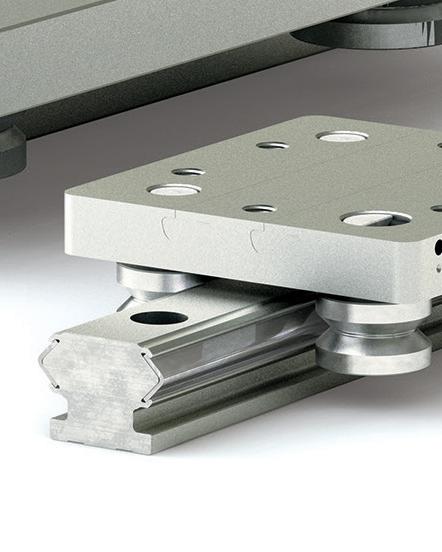




Integral-V runs along a precision machined anodized aluminum rail with high-speed v-wheel cam rollers, eliminating mounting components, and cutting assembly time in half. Ideal for contaminated environments and high speed/acceleration applications. Rails are SIMO® machined for precision qualified surfaces, to within 0.05 mm (0.002"), resulting in a rail with no bow, no twist, and no warp.
Dynamic loads up to 10,020 N (2,252 lb)
Lengths up to 3,650 mm (143.70 in)

V-Guide Roller Bearings & Rails

V-Guide wheels are ideal for high speed requirements, accuracy, and repeatability with precision ground, dual row angular contact ball bearings. Hardened outer way surfaces provide low friction guidance for bearings.

Axial loads up to 2,313 N (520 lb)
Lengths up to 6,000 mm (19 ft)
6402 E. Rockton Road, Roscoe • Illinois 61073 USA • +1.800.962.8979 • pbclinear.com
Learn More at : bit.ly/IVTDW2023
Double row V-Wheels ride on an embedded steel raceway for pre-aligned high performance
Permanently sealed and lubricated precision dual row bearing construction
Patented side adjust enables pre-load adjustment without removing load from carriage
M12-L
Field-wireable and overmoulded
4+FE, 63 V DC up to 16 A
Degree of protection IP67 (mated)
Solder, dip solder and stranded versions

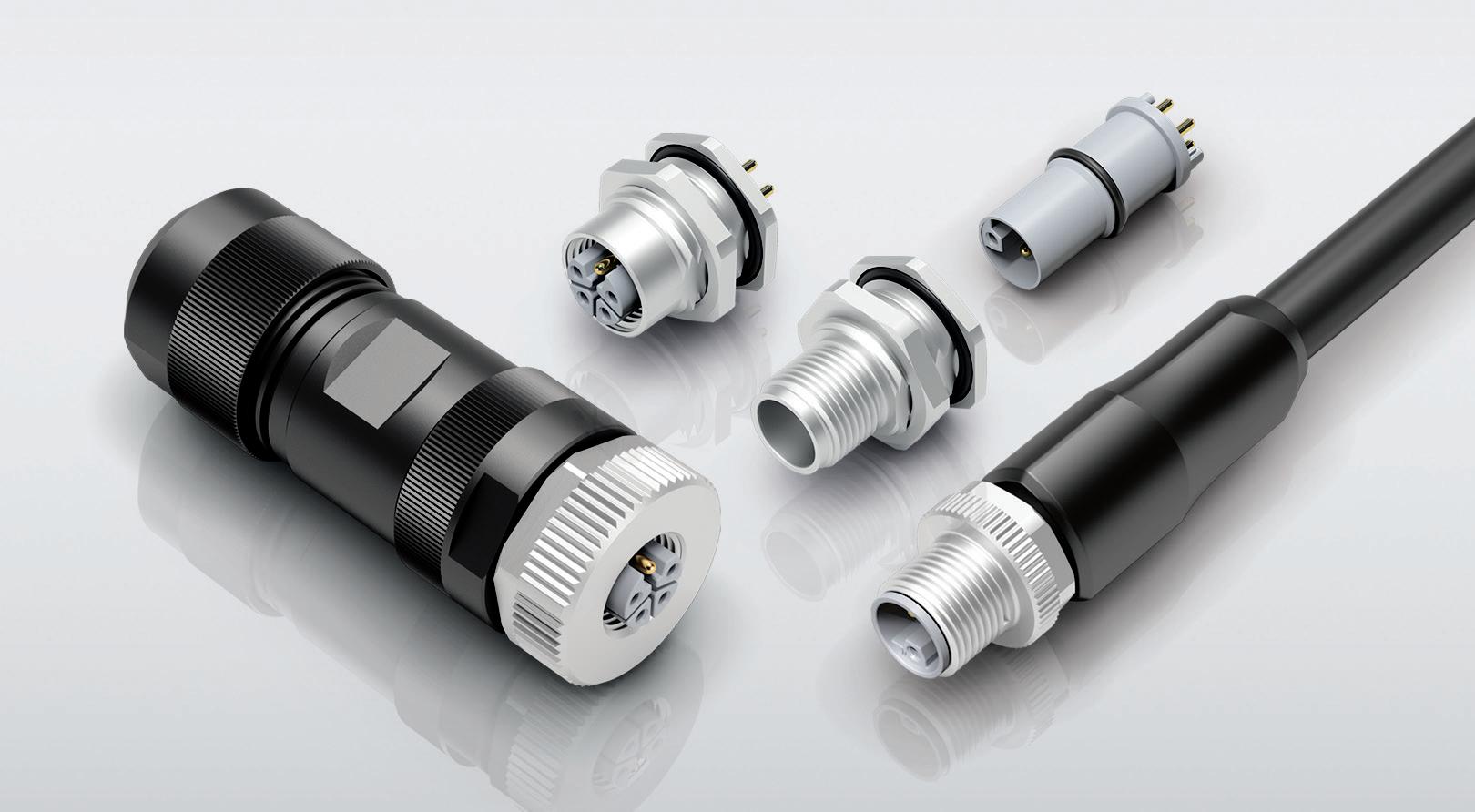

www.binder-usa.com




















































































































 Paul J. Heney - VP, Editorial Director
Paul J. Heney - VP, Editorial Director




































































































































































































































 Edited by Mike Santora Managing Editor
Edited by Mike Santora Managing Editor







 Edited by Mike Santora • Managing Editor
Edited by Mike Santora • Managing Editor















































































































































































































































































































































































































































































